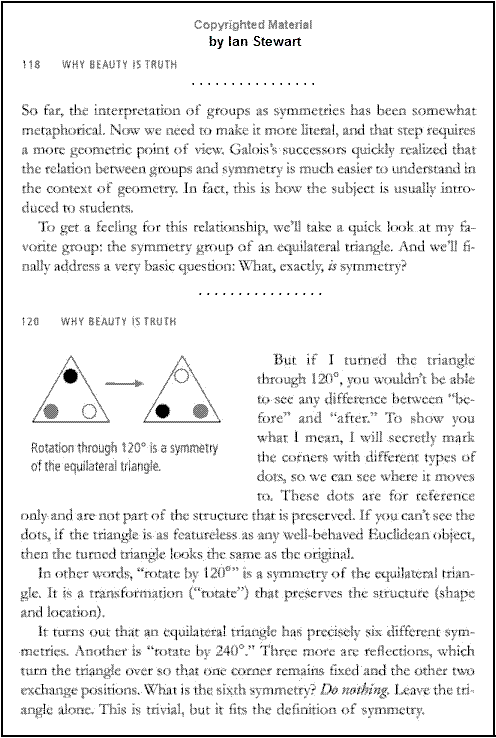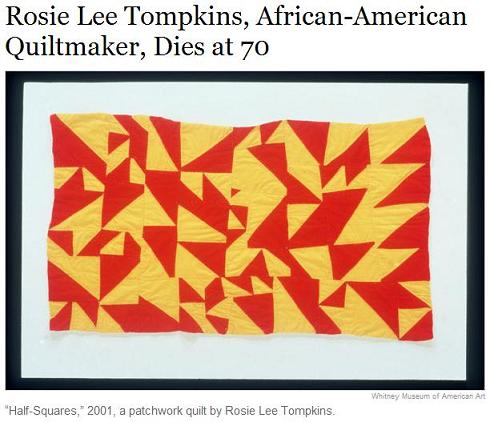Tuesday, November 21, 2023
The phrase "the mathematical concept of invariance of symmetry"
in the previous post suggests a Google search . . .

For those who prefer narrative to mathematics, the search result
"The Time Invariance of Snow" is not without interest.
See also "Snow Queen" in this journal.
Comments Off on Mathematics and Narrative: Symmetry and the Snow Queen
Wednesday, February 15, 2023
Continues.
Mathematics:
From Log24 "Pyramid Game" posts —

The letter labels, but not the tetrahedron, are from Whitehead’s
The Axioms of Projective Geometry (Cambridge U. Press, 1906), page 13.
Narrative:


Comments Off on Mathematics and Narrative . . .
Monday, December 19, 2022

Midrash from Philip Pullman . . .
"The 1929 Einstein-Carmichael Expedition"

I prefer the 1929 Emch-Carmichael expedition —

This is from . . .

“By far the most important structure in design theory
is the Steiner system S(5, 8, 24).”
— “Block Designs,” by Andries E. Brouwer
(Ch. 14 (pp. 693-746) of Handbook of Combinatorics,
Vol. I, MIT Press, 1995, edited by Ronald L. Graham,
Martin Grötschel, and László Lovász, Section 16 (p. 716))
Comments Off on Mathematics and Narrative, Continued . . .
“Apart from that, Mrs. Lincoln . . .”
Thursday, March 24, 2022
"Solomon Golomb’s classic book Shift Register Sequences,
published in 1967—based on his work in the 1950s—
went out of print long ago. But its content lives on. . . ."
For part of that content, see Stencils .
A :Log24 post from the date of Golomb's death —

See as well other posts on Mathematics and Narrative.
Comments Off on Mathematics and Narrative: Solomon vs. the Wicked Queen
Sunday, March 21, 2021
“To conquer, three boxes* have to synchronize and join together into the Unity.”
―Wonder Woman in Zack Snyder’s Justice League

See also The Unity of Combinatorics and The Miracle Octad Generator.
* Cf. Aitchison’s Octads —

Comments Off on Mathematics and Narrative: The Unity
Monday, May 25, 2020
Mathematics: This journal on September 1, 2011 —
Posts tagged September Morn.
Narrative: Also on September 1, 2011 —

See as well Nabokov’s Magic Carpet.
Comments Off on Mathematics and Narrative
Monday, March 16, 2020
Expanding the Spielraum
Mathematics: See Tetrahedron vs. Square in this journal
(Notes on two different models of schoolgirl space ).
Narrative: Replacing the square from the above posts by
a related cube …

… yields a merchandising inspiration —
Dueling Holocrons:
Jedi Cube vs. Sith Tetrahedron —
 .
.
* See also earlier posts on Mathematics and Narrative.
Comments Off on Mathematics and Narrative* Continues:
Tuesday, August 6, 2019

"There is such a thing as a desktop."
— Saying adapted from a 1962 young-adult novel.
Comments Off on Mathematics and Narrative: The Crosswicks Curse Continues.
Thursday, November 15, 2018
Mathematics —
See (for instance) a research group at Ghent University.
For those who prefer narrative . . .

See also . . .

Comments Off on Mathematics and Narrative
Sunday, August 26, 2018
Mathematics —

Narrative —

See also other recent posts tagged Queensland.
Comments Off on Mathematics and Narrative: Queensland
Thursday, August 16, 2018
(Continued)
Mathematics:

Narrative:

Comments Off on Mathematics and Narrative
Wednesday, February 28, 2018
(Continued)
Excerpts from a post of May 25, 2005 —

Above is an example I like of mathematics….
Here is an example I like of narrative:
Kate felt quite dizzy. She didn't know exactly what it was
that had just happened, but she felt pretty damn certain that
it was the sort of experience that her mother would not have
approved of on a first date.
"Is this all part of what we have to do to go to Asgard?"
she said. "Or are you just fooling around?"
"We will go to Asgard...now," he said.
At that moment he raised his hand as if to pluck an apple,
but instead of plucking he made a tiny, sharp turning movement.
The effect was as if he had twisted the entire world through a
billionth part of a billionth part of a degree. Everything
shifted, was for a moment minutely out of focus, and then
snapped back again as a suddenly different world.
— Douglas Adams, The Long Dark Tea-Time of the Soul
Image from a different different world —

Hat-tip to a related Feb. 26 weblog post
at the American Mathematical Society.
Comments Off on Mathematics and Narrative
Monday, February 20, 2017
Mathematics —
Hudson's parametrization of the
4×4 square, published in 1905:

A later parametrization, from this date in 1986:

A note from later in 1986 shows the equivalence of these
two parametrizations:
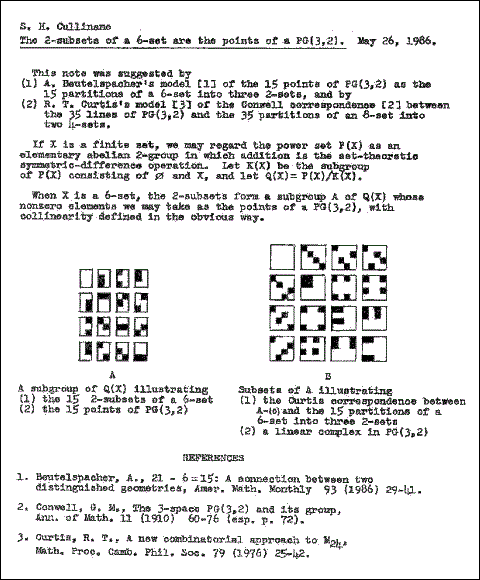
Narrative —
Posts tagged Memory-History-Geometry.
The mathematically challenged may prefer the narrative of the
Creation Matrix from the religion of the Transformers:
"According to religious legend, the core of the Matrix
was created from Solomus, the god of wisdom,
trapped in the form of a crystal by Mortilus, the god
of death. Following the defeat of Mortilus, Solomus
managed to transform his crystal prison into the Matrix—
a conduit for the energies of Primus, who had himself
transformed into the life-giving computer Vector Sigma."
Comments Off on Mathematics and Narrative
Wednesday, June 1, 2016
Principles before Personalities — AA Saying .
Principles —
See Schoolgirl Problem in Wikipedia.
Personalities —
See Alexandra Alter in the May 26 online New York Times :
"With the proliferation of 'girl' titles,
there are signs that the trend may have peaked;
it already seems ripe for parody."

Update of 12:40 PM ET on Wednesday, June 1, 2016 —
A note for the Church of Synchronology …
See a post from this journal on the date of the Alter piece, May 26:
(Click image for the rest of the post .)

Comments Off on Mathematics and Narrative
Wednesday, November 26, 2014
Comments Off on Mathematics and Narrative
Friday, October 17, 2014
Raiders of the Lost Archetype
“… an unexpected development: the discovery of a lost archetype….”
— “The Lost Theorem,” by Lee Sallows, Mathematical Intelligencer, Fall 1997
Related material:

A scene from the 1954 film:

A check of this journal on the above MetaFilter date — Jan. 24, 2012 —
yields a post tagged “in1954.” From another post with that tag:
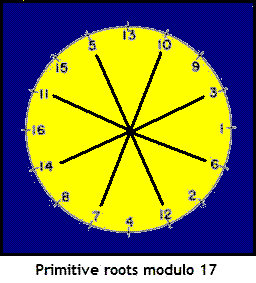
Backstory: Posts tagged Root Circle.
Comments Off on Mathematics and Narrative, continued:
Monday, October 13, 2014
For those who prefer drama to mathematics:

See also Magic + Flute in this journal.
Comments Off on Mathematics and Narrative, continued
Saturday, September 21, 2013
Mathematics:
A review of posts from earlier this month —
Wednesday, September 4, 2013
Unexpected connections between areas of mathematics
previously thought to be unrelated are sometimes referred
to as "moonshine." An example— the apparent connections
between parts of complex analysis and groups related to the
large Mathieu group M24. Some recent work on such apparent
connections, by Anne Taormina and Katrin Wendland, among
others (for instance, Miranda C.N. Cheng and John F.R. Duncan),
involves structures related to Kummer surfaces .
In a classic book, Kummer's Quartic Surface (1905),
R.W.H.T. Hudson pictured a set of 140 structures, the 80
Rosenhain tetrads and the 60 Göpel tetrads, as 4-element
subsets of a 16-element 4×4 array. It turns out that these
140 structures are the planes of the finite affine geometry
AG(4,2) of four dimensions over the two-element Galois field.
(See Diamond Theory in 1937.)
Thursday, September 5, 2013
(Continued from yesterday)
The foreword by Wolf Barth in the 1990 Cambridge U. Press
reissue of Hudson's 1905 classic Kummer's Quartic Surface
covers some of the material in yesterday's post Moonshine.
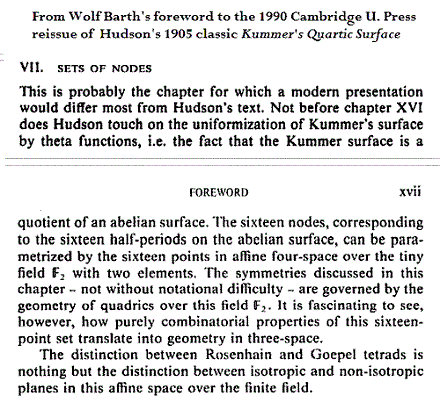
The distinction that Barth described in 1990 was also described, and illustrated,
in my 1986 note "Picturing the smallest projective 3-space." The affine 4-space
over the the finite Galois field GF(2) that Barth describes was earlier described—
within a 4×4 array like that pictured by Hudson in 1905— in a 1979 American
Mathematical Society abstract, "Symmetry invariance in a diamond ring."
"The distinction between Rosenhain and Goepel tetrads
is nothing but the distinction between isotropic and
non-isotropic planes in this affine space over the finite field."
The 1990 paragraph of Barth quoted above may be viewed as a summary
of these facts, and also of my March 17, 2013, note "Rosenhain and Göpel
Tetrads in PG(3,2)."
|
Narrative:

Aooo.
Happy birthday to Stephen King.
Comments Off on Mathematics and Narrative (continued)
Friday, July 5, 2013
Short Story — (Click image for some details.)

Parts of a longer story —
The Galois Tesseract and Priority.
Comments Off on Mathematics and Narrative (continued)
Thursday, May 9, 2013
"Why history?
Well, the essence of history is story ,
and a good story is an end in itself."
— Barry Mazur, "History of Mathematics as a tool,"
February 17, 2013
|
This journal on February 17, 2013:
"Currently in post-production": The Zero Theorem.
Raiders of the Lost Tesseract continues…
SOCRATES: Is he not better off in knowing his ignorance?
MENO: I think that he is.
SOCRATES: If we have made him doubt, and given him the 'torpedo's shock,' have we done him any harm?
MENO: I think not.
Torpedo… LOS!
|

See also today's previous post.
Comments Off on Mathematics and Narrative (continued)
Sunday, April 28, 2013
See Snakes on a Projective Plane by Andrew Spann (Sept. 26, 2006):

Click image for some related posts.
"…what he was trying to get across was not that he was the Soldier of a Power that was fighting across all of time to change history, but simply that we men were creatures with imaginations and it was our highest duty to try to tell what it was really like to live in other times and places and bodies. Once he said to me, 'The growth of consciousness is everything… the seed of awareness sending its roots across space and time. But it can grow in so many ways, spinning its web from mind to mind like the spider or burrowing into the unconscious darkness like the snake. The biggest wars are the wars of thought.' "
— Fritz Leiber, Changewar , page 22
Comments Off on Mathematics and Narrative (continued)
Tuesday, March 19, 2013
Angels & Demons meet Hudson Hawk
Dan Brown's four-elements diamond in Angels & Demons :

The Leonardo Crystal from Hudson Hawk :

Hudson:

Mathematics may be used to relate (very loosely)
Dan Brown's fanciful diamond figure to the fanciful
Leonardo Crystal from Hudson Hawk …
"Giving himself a head rub, Hawk bears down on
the three oddly malleable objects. He TANGLES
and BENDS and with a loud SNAP, puts them together,
forming the Crystal from the opening scene."
— A screenplay of Hudson Hawk
Happy birthday to Bruce Willis.
Comments Off on Mathematics and Narrative (continued)
Thursday, February 7, 2013
Primes Are Forever
"If diamonds are a girl's best friend,
prime numbers are a mathematician's….
A Mersenne prime is of the form 2P-1,
where the variable P is itself a prime—
making the Mersenne an elite sort of prime,
a James Bond among spies."
— Anonymous author at
Fox News, Feb. 5, 2013
The author notes that the smaller
Mersenne primes include 7.
Related Material
April 7, 2003:
April is Math Awareness Month.
This year's theme is "mathematics and art."

Update of 2:56 PM Feb. 7:
See also Paul Bateman and, in this journal, the date of Bateman's death.
For mathematics rather than narrative, see (for instance)…

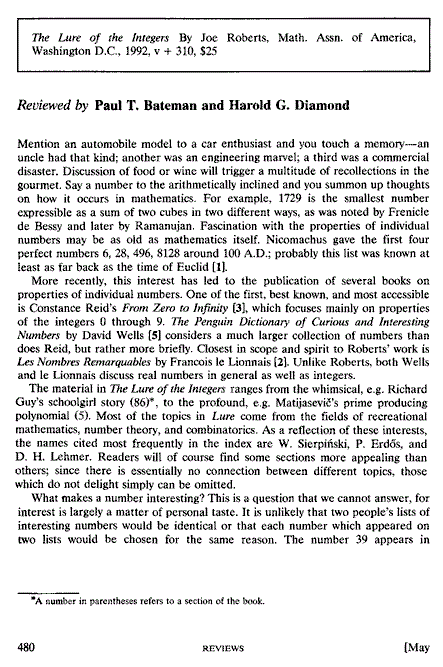 .
.
Comments Off on Mathematics and Narrative, continued…
Thursday, September 27, 2012
In diamond-narrative news today…

"Among the low points of his career was his performance
in the disastrous 1985 remake of “King Solomon’s Mines….”
— David Belcher in today's online New York Times
Comments Off on Mathematics and Narrative (continued)
Friday, January 27, 2012
Princeton University Press on a book it will publish in March—
Circles Disturbed: The Interplay of Mathematics and Narrative
"Circles Disturbed brings together important thinkers in mathematics, history, and philosophy to explore the relationship between mathematics and narrative. The book's title recalls the last words of the great Greek mathematician Archimedes before he was slain by a Roman soldier— 'Don't disturb my circles'— words that seem to refer to two radically different concerns: that of the practical person living in the concrete world of reality, and that of the theoretician lost in a world of abstraction. Stories and theorems are, in a sense, the natural languages of these two worlds–stories representing the way we act and interact, and theorems giving us pure thought, distilled from the hustle and bustle of reality. Yet, though the voices of stories and theorems seem totally different, they share profound connections and similarities."
Timeline of the Marvel Cinematic Universe — Norway, March 1942—
"The Red Skull finds the Tesseract, a cube of strange power,
said to be the jewel of Odin’s treasure room, in Tonsberg Norway.
(Captain America: The First Avenger)"
Tesseracts Disturbed — (Click to enlarge)

Detail of Tesseracts Disturbed —

Narrative of the detail—
See Tesseract in this journal and Norway, May 2010—
The Oslo Version and Annals of Conceptual Art.
"Oh, what a tangled web we weave…"
Comments Off on Mathematics and Narrative (continued)
Tuesday, December 13, 2011
Mathematics —
(Some background for the Galois tesseract )
(Click to enlarge)

Narrative —
An essay on science and philosophy in the January 2012
Notices of the American Mathematical Society .
Note particularly the narrative explanation of the double-slit experiment—
"The assertion that elementary particles have
free will and follow Quality very closely leads to
some startling consequences. For instance, the
wave-particle duality paradox, in particular the baffling
results of the famous double slit experiment,
may now be reconsidered. In that experiment, first
conducted by Thomas Young at the beginning
of the nineteenth century, a point light source
illuminated a thin plate with two adjacent parallel
slits in it. The light passing through the slits
was projected on a screen behind the plate, and a
pattern of bright and dark bands on the screen was
observed. It was precisely the interference pattern
caused by the diffraction patterns of waves passing
through adjacent holes in an obstruction. However,
when the same experiment was carried out much
later, only this time with photons being shot at
the screen one at a time—the same interference
pattern resulted! But the Metaphysics of Quality
can offer an explanation: the photons each follow
Quality in their actions, and so either individually
or en masse (i.e., from a light source) will do the
same thing, that is, create the same interference
pattern on the screen."
This is from "a Ph.D. candidate in mathematics at the University of Calgary."
His essay is titled "A Perspective on Wigner’s 'Unreasonable Effectiveness
of Mathematics.'" It might better be titled "Ineffective Metaphysics."
Comments Off on Mathematics and Narrative, continued
Thursday, October 13, 2011
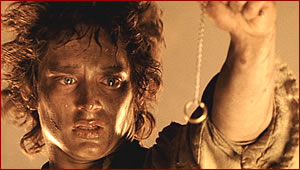
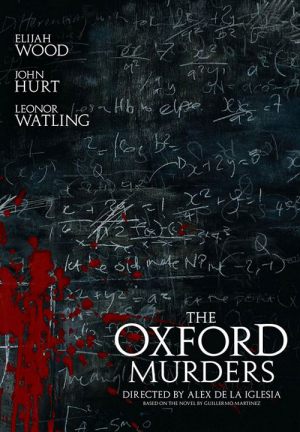
"I've got a little story you oughta know…."
Comments Off on Mathematics and Narrative, continued
Friday, September 2, 2011

See also this journal on October 10, 2010.
Comments Off on Mathematics and Narrative (continued)
Thursday, January 27, 2011
Indiana Jones and the Magical Oracle
Mathematician Ken Ono in the December 2010 American Mathematical Society Notices—

The "dying genius" here is Ramanujan, not Galois. The story now continues at the AMS website—

(Excerpt from Jan. 27 screenshot;
the partitions story has been the top
news item at the site all week.)
From a Jan. 20, 2011, Emory University press release —
"Finite formula found for partition numbers" —
"We found a function, that we call P, that is like a magical oracle," Ono says. "I can take any number, plug it into P, and instantly calculate the partitions of that number. P does not return gruesome numbers with infinitely many decimal places. It's the finite, algebraic formula that we have all been looking for."
For an introduction to the magical oracle, see a preprint, "Bruinier-Ono," at the American Institute of Mathematics website.
Ono also discussed the oracle in a video (see minute 25) recorded Jan. 21 and placed online today.
See as well "Exact formulas for the partition function?" at mathoverflow.net.
A Nov. 29, 2010, remark by Thomas Bloom on that page leads to a 2006 preprint by Ono and Kathrin Bringmann, "An Arithmetic Formula for the Partition Function*," that seems not unrelated to Ono's new "magical oracle" formula—
Click to enlarge

The Bruinier-Ono paper does not mention the earlier Bringmann-Ono work.
(Both the 2011 Bruinier-Ono paper and the 2006 Bringmann-Ono paper mention their debt to a 2002 work by Zagier— Don Zagier, "Traces of singular moduli," in Motives, Polylogarithms and Hodge theory, Part II (Irvine, CA, 1998), International Press Lecture Series 3 (International Press, Somerville, MA, 2002), pages 211-244.)
Some background for those who prefer mathematics to narrative—
The Web of Modularity: Arithmetic of the Coefficients of Modular Forms and q-Series ,
by Ken Ono, American Mathematical Society CBMS Series, 2004.
* Proc. Amer. Math. Soc. 135 (2007), 3507-3514.
Comments Off on Mathematics and Narrative, continued…
Friday, January 14, 2011
From 6/22, 2010 —

I would argue that at least sometimes, lottery numbers may be regarded,
according to Bernstein's definition, as story statements.
From 7/02, 2010 —

Comments Off on Mathematics and Narrative continues…
Monday, December 13, 2010
Apollo's 13: A Group Theory Narrative —
I. At Wikipedia —

II. Here —
See Cube Spaces and Cubist Geometries.
The 13 symmetry axes of the (Euclidean) cube–
exactly one axis for each pair of opposite
subcubes in the 27-part (Galois) 3×3×3 cube–

A note from 1985 describing group actions on a 3×3 plane array—

Undated software by Ed Pegg Jr. displays
group actions on a 3×3×3 cube that extend the
3×3 group actions from 1985 described above—

Pegg gives no reference to the 1985 work on group actions.
Comments Off on Mathematics and Narrative continued…
Friday, October 15, 2010
The Story of N

Roberta Smith in the New York Times of July 7, 2006—
Art Review
Endgame Art? It's Borrow, Sample and Multiply in an Exhibition at Bard College
"… The show has an endgame, end-time mood, as if we are looking at the end of the end of the end of Pop, hyperrealism and appropriation art. The techniques of replication and copying have become so meticulous that they are beside the point. This is truly magic realism: the kind you can't see, that has to be explained. It is also a time when artists cultivate hybridism and multiplicity and disdain stylistic coherence, in keeping with the fashionable interest in collectivity, lack of ego, the fluidity of individual identity. But too often these avoidance tactics eliminate the thread of a personal sensibility or focus.
I would call all these strategies fear of form, which can be parsed as fear of materials, of working with the hands in an overt way and of originality. Most of all originality. Can we just say it? This far from Andy Warhol and Duchamp, the dismissal of originality is perhaps the oldest ploy in the postmodern playbook. To call yourself an artist at all is by definition to announce a faith, however unacknowledged, in some form of originality, first for yourself, second, perhaps, for the rest of us.
Fear of form above all means fear of compression— of an artistic focus that condenses experiences, ideas and feelings into something whole, committed and visually comprehensible. With a few exceptions, forms of collage and assemblage dominate this show: the putting together (or simply putting side by side) of existing images and objects prevails. The consistency of this technique in two and three dimensions should have been a red flag for the curators. Collage has driven much art since the late 1970's. Lately, and especially in this exhibition, it often seems to have become so distended and pulled apart that its components have become virtually autonomous and unrelated, which brings us back to square one. This is most obvious in the large installations of graphic works whose individual parts gain impact and meaning from juxtaposition but are in fact considered distinct artworks."
Margaret Atwood on art and the trickster—
"The pleasures of fabulation, the charming and playful lie— this line of thought leads Hyde* to the last link in his subtitle, the connection of the trickster to art. Hyde reminds us that the wall between the artist and that American favourite son, the con-artist, can be a thin one indeed; that craft and crafty rub shoulders; and that the words artifice, artifact, articulation and art all come from the same ancient root, a word meaning 'to join,' 'to fit,' and 'to make.' If it’s a seamless whole you want, pray to Apollo, who sets the limits within which such a work can exist. Tricksters, however, stand where the door swings open on its hinges and the horizon expands: they operate where things are joined together, and thus can also come apart."
* Lewis Hyde, Trickster Makes This World: Mischief, Myth, and Art, Farrar Straus & Giroux, January 1998
Smith mentions "an artistic focus that condenses experiences, ideas and feelings into something whole, committed and visually comprehensible."
Atwood mentions "a seamless whole."
For some related remarks, see "A Study in Art Education" and the central figure pictured above. (There "N" can stand for "number," "nine," or "narrative.")
Comments Off on Mathematics and Narrative, continued
Friday, August 27, 2010
Narrative Sequence
In today's New York Times, Michiko Kakutani reviews a summer thriller by Kevin Guilfoile. The Thousand is in the manner of Dan Brown's 2003 The Da Vinci Code or of Katherine Neville's 1988 The Eight .
From the review—
What connects these disparate events, it turns out, is a sinister organization called the Thousand, made up of followers of the ancient Greek mathematician and philosopher Pythagoras (yes, the same Pythagoras associated with the triangle theorem that we learned in school).
As Mr. Guilfoile describes it, this organization is part Skull and Bones, part Masonic lodge, part something much more twisted and nefarious….
The plot involves, in part,
… an eccentric artist’s mysterious masterwork, made up of thousands of individually painted tiles that may cohere into an important message….
Not unlike the tiles in the Diamond Theory cover (see yesterday's post) or, more aptly, the entries in this journal.
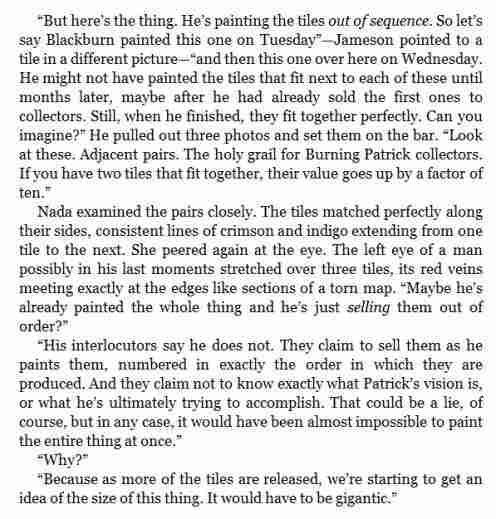
Comments Off on Mathematics and Narrative continued…
Saturday, July 17, 2010
"List, list, O, list!"
— Hamlet's father's ghost
"Ordering and patterning are not wholly narrative activities."
— James E. Giles, 1986
"See also… the true story 0, 1, 2, 3…" 
— Log24, January 9, 2009
 For some non-narrative patterning of this list, see (for instance)
For some non-narrative patterning of this list, see (for instance)
Apostol's Modular Functions and Dirichlet Series in Number Theory.
Comments Off on Mathematics and Narrative continued
Tuesday, July 13, 2010
Comments Off on Mathematics and Narrative, continued
Tuesday, June 22, 2010
"By groping toward the light we are made to realize
how deep the darkness is around us."
— Arthur Koestler, The Call Girls: A Tragi-Comedy,
Random House, 1973, page 118
A 1973 review of Koestler's book—
"Koestler's 'call girls,' summoned here and there
by this university and that foundation
to perform their expert tricks, are the butts
of some chilling satire."
Examples of Light—
Felix Christian Klein (1849- June 22, 1925) and Évariste Galois (1811-1832)
Klein on Galois—
"… in France just about 1830 a new star of undreamt-of brilliance— or rather a meteor, soon to be extinguished— lighted the sky of pure mathematics: Évariste Galois."
— Felix Klein, Development of Mathematics in the 19th Century, translated by Michael Ackerman. Brookline, Mass., Math Sci Press, 1979. Page 80.
"… um 1830 herum in Frankreich als ein neuer Stern von ungeahntem Glanze am Himmel der reinen Mathematik aufleuchtet, um freilich, einem Meteor gleich, sehr bald zu verlöschen: Évariste Galois."
— Felix Klein, Vorlesungen Über Die Entwicklung Der Mathematick Im 19. Jahrhundert. New York, Chelsea Publishing Co., 1967. (Vol. I, originally published in Berlin in 1926.) Page 88.
Examples of Darkness—
Martin Gardner on Galois—
"Galois was a thoroughly obnoxious nerd,
suffering from what today would be called
a 'personality disorder.' His anger was
paranoid and unremitting."
Gardner was reviewing a recent book about Galois by one Amir Alexander.
Alexander himself has written some reviews relevant to the Koestler book above.
See Alexander on—
The 2005 Mykonos conference on Mathematics and Narrative
A series of workshops at Banff International Research Station for Mathematical Innovation between 2003 and 2006. "The meetings brought together professional mathematicians (and other mathematical scientists) with authors, poets, artists, playwrights, and film-makers to work together on mathematically-inspired literary works."
Comments Off on Mathematics and Narrative, continued
Saturday, May 15, 2010
Comments Off on Mathematics and Narrative continued…
Thursday, May 6, 2010
The Unfolding
A post for Florencio Campomanes,
former president of the World Chess Federation.
Campomanes died at 83 in the Philippines
at 1:30 PM local time (1:30 AM Manhattan time)
on Monday, May 3, 2010.
From this journal on the date of his death —
"There is such a thing as a tesseract."
– Madeleine L'Engle
Image by Christopher Thomas at Wikipedia —
Unfolding of a hypercube and of a cube —


Related material from a story of the Philippines —

Comments Off on Mathematics and Narrative, continued…
Tuesday, May 4, 2010
Romancing the
Non-Euclidean Hyperspace
Backstory —
Mere Geometry, Types of Ambiguity,
Dream Time, and Diamond Theory, 1937

For the 1937 grid, see Diamond Theory, 1937.
The grid is, as Mere Geometry points out, a non-Euclidean hyperspace.
For the diamonds of 2010, see Galois Geometry and Solomon’s Cube.
Comments Off on Mathematics and Narrative, continued
Monday, April 12, 2010
Saturday's post quoted a mathematical narrative with the following opening sentence–
"Let G be a finite, primitive subgroup of GL(V) = GL(n,D),
where V is an n-dimensional vector space over the division ring D."
If that narrative were a novel, its opening might win a Bulwer-Lytton prize.
As might the opening of another nonfiction narrative—
"What are we are doing?"
A partial answer to this profound metaphysical question
for fans of the classic film "Dark City"
(which was written in part by one "Lem Dobbs")–
Part I — Fiction —
Shell Beach
“It was a dark and stormy night….”
– Opening of A Wrinkle in Time, a classic novel by Madeleine L’Engle.
For those who seek religious significance in the name of Hurricane Alex:
“Alex Proyas directs this futuristic thriller about a man waking up to find he is wanted for brutal murders he doesn’t remember. Haunted by mysterious beings who stop time and alter reality, he seeks to unravel the riddle of his identity.”
– Description of the 1998 film Dark City

[See also June 14, 2005.]
|
Part II — Nonfiction —

http://www.shellbeachinn.com/
Part III — Fiction —
"The bench on which Dobbs was sitting
was not so good."
— B. Traven, opening sentence
of The Treasure of the Sierra Madre
Comments Off on Mathematics and Narrative, continued
Monday, March 8, 2010
The Magic Lyre

(Click image for context.)
See also Saturday's post—
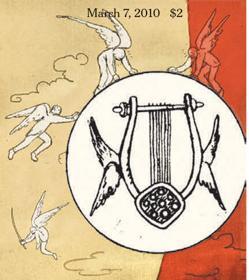
as well as Solemn Dance
and Mazur at Delphi.
(This last is apparently based on
a talk given by Barry Mazur at Delphi
in 2007 and may or may not appear in
a book, Mathematics and Narrative,
to be published in 2010.)
Suggested tune for the lyre–
"Send me the pillow
that you dream on,"
in memory of Hank Locklin,
who died on this date last year.
Comments Off on Mathematics and Narrative continued
Saturday, November 14, 2009
A graphic novel reviewed in the current Washington Post features Alfred North Whitehead and Bertrand Russell–

Related material:
Whitehead on Fano’s finite projective three-space:
“This is proved by the consideration of a three dimensional geometry in which there are only fifteen points.”
—The Axioms of Projective Geometry , Cambridge University Press, 1906
A related affine six-space:

Further reading:
See Solomon’s Cube and the link at the end of today’s previous entry, then compare and contrast the above portraits of Whitehead and Russell with Charles Williams’s portraits of Sir Giles Tumulty and Lord Arglay in the novel Many Dimensions .
“It was a dark and stormy night….“
Comments Off on Mathematics and Narrative, continued:
Monday, December 11, 2023
"The present article elaborates on a talk presented at the first
'Mathematics and Narrative' conference (Mykonos, July 12-15, 2005)."
— Leo Corry on his "Calculating the Limits of Poetic License"
"In this article I seek to clarify the role played by poetic license
in the triangular relationship involving mathematics, the history
of mathematics and mathematics in fiction."
— Leo Corry, https://www.tau.ac.il/~corry/publications/articles.html . . .
html/
pdf
|
"Calculating the Limits of Poetic License:
Fictional Narrative and the History of Mathematics",
Configurations 15 (3) (2007), 195-226. (German translation:
"Berechnungen zur Grenze der poetischen Freiheit:
Fiktionales Erzählen und die Geschichte der Mathematik",
in Andrea Albrecht et al (eds.) Zahlen, Zeichen und Figuren:
Mathematische Inspirationen in Kunst und Literatur, Berlin:
De Gruyter (2011), pp. 564-599.)
|
See also tonight's previous post.
Comments Off on Triangular Relationship at Mykonos
Thursday, June 2, 2022
Mathematics and Narrative continues . . .
The Mystic Equation
"6/2 = 3"
as
Holy Seed:

Comments Off on The Separatrix: 6/2
Friday, March 25, 2022
From the "Mathematics and Narrative" link in the previous post —

An image reposted here on March 12, 2022, the reported date of death
for Vera Diamantova —


Helen Mirren with plastic Gankyil .
Comments Off on The Diamantova Logo
Friday, October 23, 2020
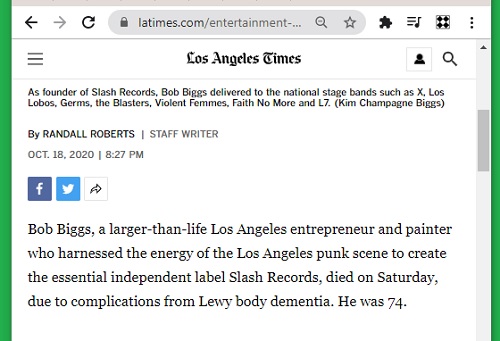
Midrash for the late Harold Bloom,
author of The Daemon Knows —
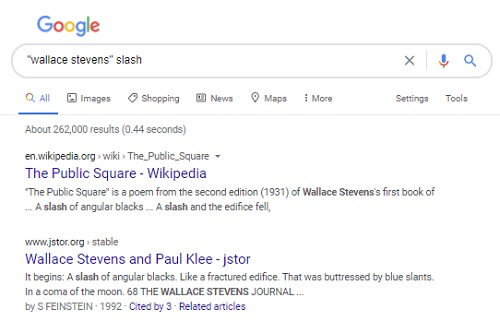
It is perhaps not irrelevant that the phrase "on Saturday" in the
Los Angeles Times of Sunday, October 18, 2020, refers to the
preceding day — October 17, 2020. See too that date here.
Related material —

— November 2020
Notices of the American Mathematical Society
For fans of mathematics and narrative —
Some may fancy Bloom as a dybbuk (cf, "A Serious Man") turning
the page in the article above to the next page, 1590 —


Comments Off on News from Saint Luke’s Day
Saturday, November 17, 2018

See as well . . .

. . . and posts tagged Alperin.
On its current homepage, the American Mathematical Society
links to a Nov. 15 blog post illustrating the Stan Lee approach
to mathematics:
Stories: "Math needs more stories. All kinds of stories…" —

See too Mathematics and Narrative in this journal.
Comments Off on Representation
Thursday, February 23, 2017
Continued.
" The origin of new ways of doing things may often be
a disciplinary crisis. The definition of such a crisis
provided by Barry Mazur in Mykonos (2005) applies
equally well to literary creation. '[A crisis occurs] when
some established overarching framework, theoretical
vocabulary or procedure of thought is perceived as
inadequate in an essential way, or not meaning
what we think it means.' "
— Circles Disturbed :
The Interplay of Mathematics and Narrative
Edited by Apostolos Doxiadis & Barry Mazur
Princeton University Press, 2012. See
Chapter 14, Section 5.1, by Uri Margolin.
See also "overarching" in this journal.
Comments Off on Bullshit Studies
Friday, August 12, 2016
Peter Galison, a Harvard professor, is a defender of
the Vienna Circle and the religion of Scientism.
From Galison's “Structure of Crystal, Bucket of Dust,” in
Circles Disturbed: The Interplay of Mathematics and Narrative ,
edited by Apostolos Doxiadis and Barry Mazur, pp. 52-78
(Princeton: Princeton U. Press, 2012) …
Galison's final paragraph —
"Perhaps, then, it should not surprise us too much if,
as Wheeler approaches the beginning-end of all things,
there is a bucket of Borelian dust. Out of this filth,
through the proposition machine of quantum mechanics
comes pregeometry; pregeometry makes geometry;
geometry gives rise to matter and the physical laws
and constants of the universe. At once close to and far
from the crystalline story that Bourbaki invoked,
Wheeler’s genesis puts one in mind of Genesis 3:19:
'In the sweat of thy face shalt thou eat bread, till thou
return unto the ground; for out of it wast thou taken:
for dust thou art, and unto dust shalt thou return.' "
For fans of Scientism who prefer more colorful narratives —

Comments Off on Dustbucket Physics
Wednesday, August 10, 2016

The novel Blood on Snow , set in Oslo, was published
by Knopf on April 7, 2015. This journal on that date —
A related image —

Comments Off on Narratives
Tuesday, May 10, 2016
Comments Off on Game Theory
Sunday, January 10, 2016
Madeleine L'Engle meets Captain America —

This is from a Jan. 27, 2012, post on mathematics and narrative.
Related literary criticism by the late Florence King —
"Given all the historical personages the author whistles in,
one more won't hurt. Nicolas Boileau, the 17th-century
French literary critic, gave writers a piece of advice that
Ms. Neville could use: 'Make not your tale of accidents
too full / too much variety will make it dull / Achilles' rage
alone, when wrought with skill /Abundantly does a whole
"Iliad" fill.' "
— NY Times review of The Eight , a novel by Katherine Neville
Comments Off on Sunday Morning Narrative
Monday, December 7, 2015
From "AMNESIA: VARIOUS, LUMINOUS, FIXED,"
An exhibition by Joseph Kosuth at
Sprüth Magers Gallery London,
NOVEMBER 26 2014 – FEBRUARY 14 2015 —

This journal, NOVEMBER 26 2014 –
This journal, FEBRUARY 14 2015 —

Comments Off on Wittgenstein Illustrated
Thursday, April 16, 2015
"Celebrate National Library Week 2015 (April 12-18, 2015)
with the theme "Unlimited possibilities @ your library®."
See also Library of Hell.
A page from Princeton University Press on March 18, 2012:

… "mathematics and narrative…." (top of page xvii).
I prefer the interplay of Euclidean and Galois mathematics.
Comments Off on National Library Week
Monday, April 13, 2015
(A sequel to yesterday's Orthodox Easter posts)
This morning's Google News —

The New York Times on the late Günter Grass —
"Many of Mr. Grass’s books are phantasmagorical
mixtures of fact and fantasy, some of them inviting
comparison with the Latin American style known as
magical realism. His own name for this style was
'broadened reality.'"
From p. xii of the 2005 second edition of a book discussed
in yesterday's Orthodox Easter posts —
(Click image to enlarge.)
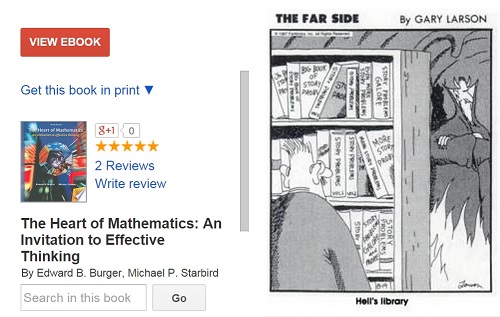
Early editions of The Heart of Mathematics include
Gary Larson's legendary Hell's Library "Far Side" cartoon.
Books in Hell's Library include Big Book of Story Problems ,
More Story Problems , and Even More Story Problems .
— Adapted from a review of the 2000 first edition
See also Mathematics and Narrative in this journal.
Comments Off on Unorthodox Easter
Tuesday, April 7, 2015
Seven years ago in this journal —
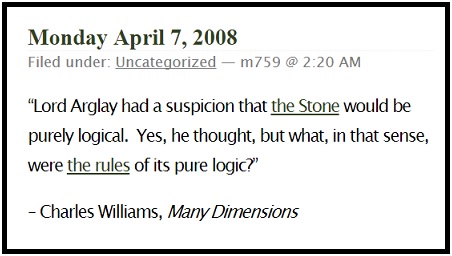
The above links: the Stone, the rules.
Comments Off on Logic
Thursday, February 12, 2015
Continued from yesterday.
The passage on Claude Chevalley quoted here
yesterday in the post Dead Reckoning was, it turns out,
also quoted by Peter Galison in his essay "Structure of Crystal,
Bucket of Dust" in Circles Disturbed: The Interplay of
Mathematics and Narrative (Princeton University Press, 2012,
ed. by Apostolos Doxiadis and Barry Mazur).
Galison gives a reference to his source:
"From 'Claude Chevalley Described by His Daughter (1988),'
in Michèle Chouchan, Nicolas Bourbaki: Faits et légendes
(Paris: Éditions du Choix, 1995), 36–40, translated and cited
in Marjorie Senechal, 'The Continuing Silence of Bourbaki:
An Interview with Pierre Cartier, June 18, 1997,'
Mathematical Intelligencer 1 (1998): 22–28."
Galison's essay compares Chevalley with the physicist
John Archibald Wheeler. His final paragraph —
"Perhaps, then, it should not surprise us too much if,
as Wheeler approaches the beginning-end of all things,
there is a bucket of Borelian dust. Out of this filth,
through the proposition machine of quantum mechanics
comes pregeometry; pregeometry makes geometry;
geometry gives rise to matter and the physical laws
and constants of the universe. At once close to and far
from the crystalline story that Bourbaki invoked,
Wheeler’s genesis puts one in mind of Genesis 3:19:
'In the sweat of thy face shalt thou eat bread, till thou
return unto the ground; for out of it wast thou taken:
for dust thou art, and unto dust shalt thou return.'"
See also posts tagged Wheeler.
Comments Off on Dead Reckoning
Friday, January 9, 2015
(An episode of Mathematics and Narrative .)
Mathematician Peter J. Cameron this morning
on a Paris anthropological exhibition subtitled
Révélation d’un temps sans fin —
"I was reminded of Herbert Read’s
novel The Green Child ."
Related recent posts from this journal:
Seal for the Seventh, Forthright, and Fourth Right.
A passage from The Green Child :
"He watched over her until he too began to feel
overpowered by a desire to sleep. He therefore
got out on to the ledge of the trough and pulled
the Green Child after him. The rock there was
warm, smooth as jade to the flesh. They lay there
and sank into a profound slumber."
Sweet dreams, Mr. Taylor.
Green Child on the Rocks —

Comments Off on Plan 9 Continues
Thursday, September 25, 2014
Recommended reading for Josefine Lyche:

See also Ayn Sof (Jan. 7, 2011).
Comments Off on Theology and Art
Monday, June 23, 2014
Or: Mathematics and Narrative, Continued
In memory of a Stanford Arabist who reportedly died yesterday:

Another dream palace, from science fiction:

From Catherine Asaro’s The Spacetime Pool :
|
She couldn’t believe him. That he sounded sane made none of this more plausible. “And you have no idea how this gate works?” she challenged.
His gaze flashed. “Of course I do. It’s a branch. From here to your mountains.”
“A tree, you mean?”
“No. A branch cut to another page. Your universe is one sheet, mine is another.”
She gaped at him. “Do you mean a Riemann sheet? A branch cut from one Riemann sheet to another?”
“That’s right.” He hesitated. “You know these words?”
She laughed unsteadily. “It’s nonsense. Not the sheets, I mean, but they’re just mathematical constructs! They don’t actually exist. You can’t physically go through a branch cut any more than you could step into a square root sign.”
He was watching her with an expression that mirrored how she had felt when he told her about his prophecy. “I have no idea what you’re talking about.”
“Complex variable analysis.” She felt as if she were in a play where she only knew part of the script. “A branch cut is like a slit in a sheet of paper. It opens onto another sheet. I suppose you could say the sheets are alternate universes. But they aren’t real.”
“They seem quite real,” he said. |
Related material: From Sunday, the day of the Stanford Arabist’s death,
a quotation from a 2013 book on “the rise of complex function theory.”
Comments Off on Dream Palace
Tuesday, March 25, 2014
(Continued)
"Richard Hughes’s celebrated short novel is
a masterpiece of concentrated narrative."
— New York Review of Books on
A High Wind in Jamaica
As perhaps were, in their way, parts of the life
of the late Patrice Wymore Flynn, who reportedly
died at 87 on Saturday.
Deep backstory: See Colony of Santiago (Jamaica).
For the "mathematics" part of this post's title, see
Saturday's Log24 post on Kummer-surface terms
and a post of September 23, 2012.
Comments Off on Narrative and Mathematics
Sunday, November 3, 2013
The title, that of a novel by Arthur Koestler,
has appeared before in this journal.
The title was quoted in a Log24 note of
May 29, 2002 (G.K. Chesterton's birthday).
The link in Saturday evening's post to a Chesterton
essay suggested a further search that yielded
the following quotation—
Then silence sank. And slowly
Arose the sea-land lord
Like some vast beast for mystery,
He filled the room and porch and sky,
And from a cobwebbed nail on high
Unhooked his heavy sword.
— G. K. Chesterton,
The Ballad of the White Horse
This, together with some Log24 remarks
from 2004, suggests two images—
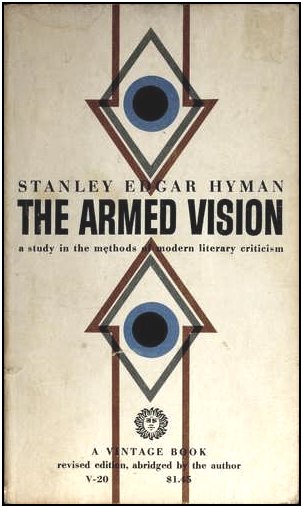
Above: A 1955 cover design by Robert Flynn.
The arrow theme also appears in a figure from
John Sealander's Road to Nowhere in the 2004
remarks:

The remarks quoting the Sealander image, from
March 5, 2004, were on mathematics and narrative.
Related material from a year later:
See an announcement, saved from March 16, 2005,
of a conference on mathematics and narrative that
was held in July 2005. Some context: Koestler's novel.
Comments Off on The Call Girls
Thursday, August 29, 2013
(Mathematics and Narrative, continued from May 9, 2013)


See also Scriba's The Concept of Number and,
from the date of his death, The Zero Theorem.
Comments Off on An End in Itself
Tuesday, May 14, 2013
Comments Off on Snakes on a Plane
Sunday, April 28, 2013
Thursday, October 25, 2012
Mathematics and Narrative continues…

Steiner's version of "classical functional analysis"—

"Mein Führer… Steiner…"

* See the story by Kilgore Trout. See also On Linguistic Creation,
The Matrix of Abraham, and The Thoreau Foundation.
Comments Off on Bunker Bingo*
Wednesday, September 19, 2012
(Mathematics and Narrative, continued)
"My dad has a great expression,"
Steve Sabol told USA TODAY Sports
last year. "He always says, 'Tell me
a fact, and I'll learn. Tell me the truth,
and I believe. But tell me a story,
and it will live in my heart forever.' " |
Fact—
Sabol died yesterday.
Truth—
An art gallery in Oslo is exhibiting a tesseract.
Story—
The Jewel of Odin's Treasure Room
(Click to enlarge.)

* I.e., Wednesday. For some apt Nordic spirit,
see Odin's Day 2012 Trailer.
Comments Off on For Odin’s Day*
Monday, August 13, 2012
(An episode of Mathematics and Narrative )
A report on the August 9th opening of Sondheim's Into the Woods—
Amy Adams… explained why she decided to take on the role of the Baker’s Wife.
“It’s the ‘Be careful what you wish’ part,” she said. “Since having a child, I’m really aware that we’re all under a social responsibility to understand the consequences of our actions.” —Amanda Gordon at businessweek.com
Related material—
Amy Adams in Sunshine Cleaning "quickly learns the rules and ropes of her unlikely new market. (For instance, there are products out there specially formulated for cleaning up a 'decomp.')" —David Savage at Cinema Retro
Compare and contrast…
1. The following item from Walpurgisnacht 2012—

2. The six partitions of a tesseract's 16 vertices
into four parallel faces in Diamond Theory in 1937—

Comments Off on Raiders of the Lost Tesseract
Thursday, July 26, 2012
(Mathematics and Narrative, continued)
Narrative—
The Ring and The Stone from yesterday’s post, and…
“In Medieval Jewish, Christian and Islamic legends,
the Seal of Solomon was a magical signet ring
said to have been possessed by King Solomon….”
— Wikipedia article, Seal of Solomon
Mathematics—

A fact related to the mathematical
“Solomon’s seal” described above by Bell:

The reference to Edge is as follows—
[3] Edge, W. L., Quadrics over GF(2) and
their relevance for the cubic surface group,
Canadian J. Maths. 11 (1959) ….
(This reference relates Hirschfeld’s remarks
quoted above to the 64-point affine space
illustrated below (via the associated
63-point projective space PG (5, 2)).
As for the narrative’s Stone…

Comments Off on Solomon’s Seal
Wednesday, February 1, 2012
Princeton University Press on a book it will publish in March—
Circles Disturbed: The Interplay of
Mathematics and Narrative
"… brings together important thinkers in mathematics,
history, and philosophy to explore the relationship
between mathematics and narrative.
The book's title recalls the last words of the great
Greek mathematician Archimedes before he was
slain by a Roman soldier— 'Don't disturb my circles' …."
Related material—
Archimedes's Vicious Circle


Comments Off on Disturbing Archimedes
Sunday, January 22, 2012
(Backstory— Presbyterian in this journal)
Princeton University Press on a book it will publish in March—
Circles Disturbed brings together important thinkers in mathematics, history, and philosophy to explore the relationship between mathematics and narrative. The book's title recalls the last words of the great Greek mathematician Archimedes before he was slain by a Roman soldier–"Don't disturb my circles"–words that seem to refer to two radically different concerns: that of the practical person living in the concrete world of reality, and that of the theoretician lost in a world of abstraction. Stories and theorems are, in a sense, the natural languages of these two worlds–stories representing the way we act and interact, and theorems giving us pure thought, distilled from the hustle and bustle of reality. Yet, though the voices of stories and theorems seem totally different, they share profound connections and similarities.
Exercise— Discuss the above paragraph's vulgarity.
Discuss also the more robust vulgarity of Marvel Entertainment…
Context— "Marvel" in this journal, and The Cosmic Cube.
Comments Off on The Presbyterian Exorcist
Sunday, January 1, 2012
"… myths are stories, and like all narratives
they unravel through time, whereas grids
are not only spatial to start with,
they are visual structures that explicitly reject
a narrative or sequential reading of any kind."
— Rosalind Krauss in "Grids,"
October (Summer 1979), 9: 50-64.
Counterexample—

The Ninefold Square
See Coxeter and the Aleph and Ayn Sof—
Comments Off on Sunday Shul
Thursday, December 29, 2011
From Margaret Wertheim's "Outsider Physicists and the Oh-My-God Particle," New Scientist , Dec. 24, 2011—
For the past 18 years I have been collecting the works of what I have come to call "outsider physicists". I now have more than 100 such theories on my shelves. Most of them are single papers, but a number are fully fledged books, often filled with equations and technical diagrams (though I do have one that is couched as a series of poems and another that is written as a fairy tale)….
The mainstream science world has a way of dealing with people like this— dismiss them as cranks and dump their letters in the bin. While I do not believe any outsider I have encountered has done any work that challenges mainstream physics, I have come to believe that they should not be so summarily ignored.
Consider the sheer numbers. Outsider physicists have their own organisation, the Natural Philosophy Alliance, whose database lists more than 2100 theorists, 5800 papers and over 1300 books worldwide. They have annual conferences, with this year's proceedings running to 735 pages. In the time I have been observing the organisation, the NPA has grown from a tiny seed whose founder photocopied his newsletter onto pastel-coloured paper to a thriving international association with video-streamed events.
The NPA's website tells us that the group is devoted "to broad-ranging, fully open-minded criticism, at the most fundamental levels, of the often irrational and unrealistic doctrines of modern physics and cosmology; and to the ultimate replacement of these doctrines by much sounder ideas".
Very little unites this disparate group of amateurs— there are as many theories as members— except for a common belief that "something is drastically wrong in contemporary physics and cosmology, and that a new spirit of open-mindedness is desperately needed". They are unanimous in the view that mainstream physics has been hijacked by a kind of priestly caste who speak a secret language— in other words, mathematics— that is incomprehensible to most human beings. They claim that the natural world speaks a language which all of us can, or should be able to, understand.
"…a secret language— in other words, mathematics— that is incomprehensible…."
For instance, the "secret language" of Dr. Garret Sobczyk?
See a brief paper by Sobczyk in the NPA Proceedings described above.
See also Sobczyk in the February 2012 Notices of the American Mathematical Society —
"Conformal Mappings in Geometric Algebra"—

This AMS article, together with Sobczyk's list of previous publications,
indicates that, despite his appearance in the NPA Proceedings , he is definitely not a crank.
Unfortunately, publication in the Notices does not by itself guarantee respectability.
For an example, see the Mathematics and Narrative post of Dec. 13, 2011.
Comments Off on Crank Science
Thursday, November 3, 2011
Mathematics and Narrative, continued
"… a vision invisible, even ineffable, as ineffable as the Angels and the Universal Souls"
— Tom Wolfe, The Painted Word , 1975, quoted here on October 30th
"… our laughable abstractions, our wryly ironic po-mo angels dancing on the heads of so many mis-imagined quantum pins."
— Dan Conover on September 1st, 2011
"Recently I happened to be talking to a prominent California geologist, and she told me: 'When I first went into geology, we all thought that in science you create a solid layer of findings, through experiment and careful investigation, and then you add a second layer, like a second layer of bricks, all very carefully, and so on. Occasionally some adventurous scientist stacks the bricks up in towers, and these towers turn out to be insubstantial and they get torn down, and you proceed again with the careful layers. But we now realize that the very first layers aren't even resting on solid ground. They are balanced on bubbles, on concepts that are full of air, and those bubbles are being burst today, one after the other.'
I suddenly had a picture of the entire astonishing edifice collapsing and modern man plunging headlong back into the primordial ooze. He's floundering, sloshing about, gulping for air, frantically treading ooze, when he feels something huge and smooth swim beneath him and boost him up, like some almighty dolphin. He can't see it, but he's much impressed. He names it God."
— Tom Wolfe, "Sorry, but Your Soul Just Died," Forbes , 1996
"… Ockham's idea implies that we probably have the ability to do something now such that if we were to do it, then the past would have been different…"
— Stanford Encyclopedia of Philosophy
"Today is February 28, 2008, and we are privileged to begin a conversation with Mr. Tom Wolfe."
— Interviewer for the National Association of Scholars
From that conversation—
Wolfe : "People in academia should start insisting on objective scholarship, insisting on it, relentlessly, driving the point home, ramming it down the gullets of the politically correct, making noise! naming names! citing egregious examples! showing contempt to the brink of brutality!"
As for "mis-imagined quantum pins"…
This journal on the date of the above interview— February 28, 2008—

Illustration from a Perimeter Institute talk given on July 20, 2005
The date of Conover's "quantum pins" remark above (together with Ockham's remark above and the above image) suggests a story by Conover, "The Last Epiphany," and four posts from September 1st, 2011—
Boundary, How It Works, For Thor's Day, and The Galois Tesseract.
Those four posts may be viewed as either an exploration or a parody of the boundary between mathematics and narrative.
"There is such a thing as a tesseract." —A Wrinkle in Time
Comments Off on Ockham’s Bubbles–
Friday, October 28, 2011
From The Telegraph today—
Professor Peter Goldie,
born November 5 1946, died October 22 2011.
With co-author Elisabeth Schellekens, Goldie wrote
Who's Afraid of Conceptual Art?
In memoriam—
Two posts from the day, Nov. 14, 2009,
that that book was published in paperback—
For St. Lawrence O'Toole's Day and
Mathematics and Narrative, continued—
and a post from the day of Goldie's death… Araby.
See also an excerpt from Who's Afraid? .
Comments Off on Annals of Art
Friday, September 2, 2011
Sarah Tomlin in a Nature article on the July 12-15 2005 Mykonos meeting on Mathematics and Narrative—
"Today, Mazur says he has woken up to the power of narrative, and in Mykonos gave an example of a 20-year unsolved puzzle in number theory which he described as a cliff-hanger. 'I don’t think I personally understood the problem until I expressed it in narrative terms,' Mazur told the meeting. He argues that similar narrative devices may be especially helpful to young mathematicians…."
Michel Chaouli in "How Interactive Can Fiction Be?" (Critical Inquiry 31, Spring 2005), pages 613-614—
"…a simple thought experiment….*
… If the cliffhanger is done well, it will not simply introduce a wholly unprepared turn into the narrative (a random death, a new character, an entirely unanticipated obstacle) but rather tighten the configuration of known elements to such a degree that the next step appears both inevitable and impossible. We feel the pressure rising to a breaking point, but we simply cannot foresee where the complex narrative structure will give way. This interplay of necessity and contingency produces our anxious— and highly pleasurable— speculation about the future path of the story. But if we could determine that path even slightly, we would narrow the range of possible outcomes and thus the uncertainty in the play of necessity and contingency. The world of the fiction would feel, not open, but rigged."
* The idea of the thought experiment emerged in a conversation with Barry Mazur.
Barry Mazur in the preface to his 2003 book Imagining Numbers—
"But the telltale adjective real suggests two things: that these numbers are somehow real to us and that, in contrast, there are unreal numbers in the offing. These are the imaginary numbers .
The imaginary numbers are well named, for there is some imaginative work to do to make them as much a part of us as the real numbers we use all the time to measure for bookshelves.
This book began as a letter to my friend Michel Chaouli. The two of us had been musing about whether or not one could 'feel' the workings of the imagination in its various labors. Michel had also mentioned that he wanted to 'imagine imaginary numbers.' That very (rainy) evening, I tried to work up an explanation of the idea of these numbers, still in the mood of our conversation."
See also The Galois Quaternion and 2/19.

New York Lottery last evening
Comments Off on Rigged?
Friday, August 19, 2011
"Francis Bacon used the phrase instantia crucis, 'crucial instance,' to refer to something in an experiment that proves one of two hypotheses and disproves the other. Bacon's phrase was based on a sense of the Latin word crux, 'cross,' which had come to mean 'a guidepost that gives directions at a place where one road becomes two,' and hence was suitable for Bacon's metaphor."
– The American Heritage® Dictionary of the English Language, Fourth Edition
Such a cross: St. Andrew's. Some context—

X Marks the Spot scene, "The Last Crusade"
Related symbology for Dan Brown—
Neville's Labrys and Notes on Mathematics and Narrative.
Comments Off on Crux
Sunday, April 10, 2011
From last October—
A stitch in time…

Related material—
This journal on April 8—

See also "Putting Mental Health on the Map at Harvard"—
Harvard Crimson , Friday, April 8, 2011, 2:09 AM—
They're outside the Science Center with their signs, their cheer, and their smiles. They've been introducing themselves over House lists, and they want you to ask questions. They're here for you. They're the Student Mental Heath Liaisons.
Harvard's SMHL crew—they pronounce it smile—have recently launched a new website and recruited more members in their effort to foster an informed and understanding environment on campus….
Mental Health Services, SMHL said, are not meant for "students who are really 'crazy.'" Everyone is entitled to a little help smiling.

Comments Off on Finishing Up at Noon
Friday, April 8, 2011
Roberta Smith in today's New York Times —
"… the argument that painting may ultimately be about
little more than the communication of some quality of
light and space, however abstract or indirect."
— Review of "Rooms With a View" at the Met
Lowry —

Malcolm Lowry, author of Under the Volcano
Hollywood —

Related material —
"You've got to pick up every stitch…"
Comments Off on Windows
Tuesday, April 5, 2011
(A sequel to last night's "For Taylor")
On Joan Tewkesbury, who wrote the script for the 1975 film "Nashville"—
She urges writers to continue to generate new ideas
and new material. "Keep writing. The hardest thing
is to sell one script and not have another to follow it with."
One script— Yesterday's link titled "An Ordinary Evening in Tennessee"
Another— "A Point of Central Arrival"
Related material from last October—
"You've got to pick up every stitch…"
* A former governor of Tennessee who died at 80 yesterday in Nashville
Comments Off on For Ned*
Saturday, January 8, 2011
"Rosetta Stone" as a Metaphor
in Mathematical Narratives
For some backgound, see Mathematics and Narrative from 2005.
Yesterday's posts on mathematics and narrative discussed some properties
of the 3×3 grid (also known as the ninefold square ).
For some other properties, see (at the college-undergraduate, or MAA, level)–
Ezra Brown, 2001, "Magic Squares, Finite Planes, and Points of Inflection on Elliptic Curves."
His conclusion:
When you are done, you will be able to arrange the points into [a] 3×3 magic square,
which resembles the one in the book [5] I was reading on elliptic curves….
This result ties together threads from finite geometry, recreational mathematics,
combinatorics, calculus, algebra, and number theory. Quite a feat!
5. Viktor Prasolov and Yuri Solvyev, Elliptic Functions and Elliptic Integrals ,
American Mathematical Society, 1997.
Brown fails to give an important clue to the historical background of this topic —
the word Hessian . (See, however, this word in the book on elliptic functions that he cites.)
Investigation of this word yields a related essay at the graduate-student, or AMS, level–
Igor Dolgachev and Michela Artebani, 2009, "The Hesse Pencil of Plane Cubic Curves ."
From the Dolgachev-Artebani introduction–
In this paper we discuss some old and new results about the widely known Hesse
configuration of 9 points and 12 lines in the projective plane P2(k ): each point lies
on 4 lines and each line contains 3 points, giving an abstract configuration (123, 94).
PlanetMath.org on the Hesse configuration—

A picture of the Hesse configuration–

(See Visualizing GL(2,p), a note from 1985).
Related notes from this journal —
From last November —
From 2006 —
Also from 2006 —
|
Sunday November 26, 2006
m759 @ 7:26 AM
Rosalind Krauss
in "Grids," 1979:
"If we open any tract– Plastic Art and Pure Plastic Art or The Non-Objective World , for instance– we will find that Mondrian and Malevich are not discussing canvas or pigment or graphite or any other form of matter. They are talking about Being or Mind or Spirit. From their point of view, the grid is a staircase to the Universal, and they are not interested in what happens below in the Concrete.
Or, to take a more up-to-date example…."
"He was looking at the nine engravings and at the circle,
checking strange correspondences between them."
– The Club Dumas ,1993
"And it's whispered that soon if we all call the tune
Then the piper will lead us to reason."
– Robert Plant ,1971
The nine engravings of The Club Dumas
(filmed as "The Ninth Gate") are perhaps more
an example of the concrete than of the universal.
An example of the universal*– or, according to Krauss,
a "staircase" to the universal– is the ninefold square:

"This is the garden of Apollo, the field of Reason…."
– John Outram, architect
For more on the field of reason, see
Log24, Oct. 9, 2006.
A reasonable set of "strange correspondences"
in the garden of Apollo has been provided by
Ezra Brown in a mathematical essay (pdf).
Unreason is, of course, more popular.
* The ninefold square is perhaps a "concrete universal" in the sense of Hegel:
"Two determinations found in all philosophy are the concretion of the Idea and the presence of the spirit in the same; my content must at the same time be something concrete, present. This concrete was termed Reason, and for it the more noble of those men contended with the greatest enthusiasm and warmth. Thought was raised like a standard among the nations, liberty of conviction and of conscience in me. They said to mankind, 'In this sign thou shalt conquer,' for they had before their eyes what had been done in the name of the cross alone, what had been made a matter of faith and law and religion– they saw how the sign of the cross had been degraded."
– Hegel, Lectures on the History of Philosophy ,
"Idea of a Concrete Universal Unity"
"For every kind of vampire,
there is a kind of cross."
– Thomas Pynchon
|
And from last October —
"You've got to pick up every stitch…"
Comments Off on True Grid (continued)
Friday, January 7, 2011
(A continuation of this morning's Coxeter and the Aleph)
"You've got to pick up every stitch… Must be the season of the witch."
— Donovan song at the end of Nicole Kidman's "To Die For"
"As is well known, the Aleph is the first letter of the Hebrew alphabet.
Its use for the strange sphere in my story may not be accidental.
For the Kabbala, the letter stands for the En Soph ,
the pure and boundless godhead; it is also said that it takes
the shape of a man pointing to both heaven and earth, in order to show
that the lower world is the map and mirror of the higher; for Cantor's
Mengenlehre , it is the symbol of transfinite numbers,
of which any part is as great as the whole."
— Borges, "The Aleph"
Ein Sof
Ein Soph or Ayn Sof (Hebrew אין סוף, literally "without end", denoting "boundlessness" and/or "nothingness"), is a Kabbalistic term that usually refers to an abstract state of existence preceding God's Creation of the limited universe. This Ein Sof , typically referred to figuratively as the "light of Ein Sof " ("Or Ein Sof "), is the most fundamental emanation manifested by God. The Ein Sof is the material basis of Creation that, when focused, restricted, and filtered through the sefirot , results in the created, dynamic universe.
….
Cultural impact
Mathematician Georg Cantor labeled different sizes of infinity using the Aleph. The smallest size of infinity is aleph-null (ℵ0), the second size is aleph-one (ℵ1), etc. One theory about why Cantor chose to use the aleph is because it is the first letter of Ein-Sof. (See Aleph number)
|
"Infinite Jest… now stands as the principal contender
for what serious literature can aspire to
in the late twentieth and early twenty-first centuries."
— All Things Shining, a work of pop philosophy published January 4th
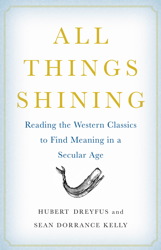
"You're gonna need a bigger boat." — Roy Scheider in "Jaws"
"We're gonna need more holy water." — "Season of the Witch," a film opening tonight
See also, with respect to David Foster Wallace, infinity, nihilism,
and the above reading of "Ayn Sof" as "nothingness,"
the quotations compiled as "Is Nothing Sacred?"
Comments Off on Ayn Sof
Tuesday, November 23, 2010
A reviewer says Steve Martin finds in his new novel An Object of Beauty "a sardonic morality tale."
From this journal on the day The Cube was published (see today's Art Object ) —
|
m759 @ 12:00 AM
The Past Revisited
From Log24 a year ago on this date, a quote from Many Dimensions (1931), by Charles Williams:
“Lord Arglay had a suspicion that the Stone would be purely logical. Yes, he thought, but what, in that sense, were the rules of its pure logic?”
For the rest of the story, see the downloadable version at Project Gutenberg of Australia.
|
See also a post on Mathematics and Narrative from Nov. 14, 2009.
That post compares characters in Many Dimensions to those in Logicomix—

Comments Off on Tale
Saturday, November 13, 2010
From the December 2010 American Mathematical Society Notices—

Related material from this journal—
Mathematics and Narrative and
Consolation Prize (August 19, 2010)
Comments Off on Story
Monday, October 25, 2010
A New York Times "The Stone" post from yesterday (5:15 PM, by John Allen Paulos) was titled—
Stories vs. Statistics
Related Google searches—
"How to lie with statistics"— about 148,000 results
"How to lie with stories"— 2 results
What does this tell us?
Consider also Paulos's phrase "imbedding the God character." A less controversial topic might be (with the spelling I prefer) "embedding the miraculous." For an example, see this journal's "Mathematics and Narrative" entry on 5/15 (a date suggested, coincidentally, by the time of Paulos's post)—
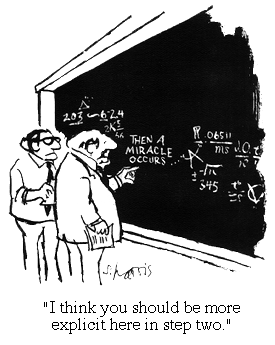
Cartoon by S.Harris
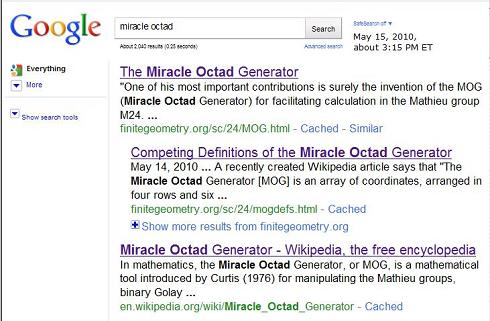
* Not directly related to the novel The Embedding discussed at Tenser, said the Tensor on April 23, 2006 ("Quasimodo Sunday"). An academic discussion of that novel furnishes an example of narrative as more than mere entertainment. See Timothy J. Reiss, "How can 'New' Meaning Be Thought? Fictions of Science, Science Fictions," Canadian Review of Comparative Literature , Vol. 12, No. 1, March 1985, pp. 88-126. Consider also on this, Picasso's birthday, his saying that "Art is a lie that makes us realize truth…."
Comments Off on The Embedding*
Thursday, October 21, 2010
Mathematics and Narrative continued
A search for Ursula in this journal yields a story…
“The main character is a slave woman who discovers new patterns in the mosaics.”
Other such stories: Plato’s Meno and Changing Woman —
Philosophical postscript—
“That Lévi-Strauss should have been able to transmute the romantic passion of Tristes Tropiques into the hypermodern intellectualism of La Pensée Sauvage is surely a startling achievement. But there remain the questions one cannot help but ask. Is this transmutation science or alchemy? Is the ‘very simple transformation’ which produced a general theory out of a personal disappointment real or a sleight of hand? Is it a genuine demolition of the walls which seem to separate mind from mind by showing that the walls are surface structures only, or is it an elaborately disguised evasion necessitated by a failure to breach them when they were directly encountered? Is Lévi-Strauss writing, as he seems to be claiming in the confident pages of La Pensée Sauvage, a prolegomenon to all future anthropology? Or is he, like some uprooted neolithic intelligence cast away on a reservation, shuffling the debris of old traditions in a vain attempt to revivify a primitive faith whose moral beauty is still apparent but from which both relevance and credibility have long since departed?”
— Clifford Geertz, conclusion of “The Cerebral Savage: On the Work of Claude Lévi-Strauss“
Comments Off on St. Ursula’s Day
Friday, October 8, 2010
… and Finishing Up at Noon
This post was suggested by last evening’s post on mathematics and narrative
and by Michiko Kakutani on Vargas Llosa in this morning’s New York Times.
“One must proceed cautiously, for this road— of truth and falsehood in the realm of fiction— is riddled with traps and any enticing oasis is usually a mirage.”
— “Is Fiction the Art of Lying?”* by Mario Vargas Llosa, New York Times essay of October 7, 1984
My own adventures in that realm— as reader, not author— may illustrate Llosa’s remark.
A nearby stack of paperbacks I haven’t touched for some months (in order from bottom to top)—
- Pale Rider by Alan Dean Foster
- Franny and Zooey by J. D. Salinger
- The Hobbit by J. R. R. Tolkien
- Le Petit Prince by Antoine de Saint Exupéry
- Literary Reflections by James A. Michener
- The Ninth Configuration by William Peter Blatty
- A Streetcar Named Desire by Tennessee Williams
- Nine Stories by J. D. Salinger
- A Midsummer Night’s Dream by William Shakespeare
- The Tempest by William Shakespeare
- Being There by Jerzy Kosinski
- What Dreams May Come by Richard Matheson
- Zen and the Art of Motorcycle Maintenance by Robert M. Pirsig
- A Gathering of Spies by John Altman
- Selected Poems by Robinson Jeffers
- Hook— Tinkerbell’s Challenge by Tristar Pictures
- Rising Sun by Michael Crichton
- Changewar by Fritz Leiber
- The Painted Word by Tom Wolfe
- The Hustler by Walter Tevis
- The Natural by Bernard Malamud
- Truly Tasteless Jokes by Blanche Knott
- The Man Who Was Thursday by G. K. Chesterton
- Under the Volcano by Malcolm Lowry
What moral Vargas Llosa might draw from the above stack I do not know.
Generally, I prefer the sorts of books in a different nearby stack. See Sisteen, from May 25. That post the fanciful reader may view as related to number 16 in the above list. The reader may also relate numbers 24 and 22 above (an odd couple) to By Chance, from Thursday, July 22.
* The Web version’s title has a misprint— “living” instead of “lying.”
Comments Off on Starting Out in the Evening
Tuesday, September 21, 2010
"I know no writing— except perhaps Henry James's introductory essays— which conveys so clearly and with such an absence of fuss the excitement of the creative artist."
— Graham Greene on A Mathematician's Apology , review in The Spectator , 20 December 1940
"The mere quality and play of an ironic consciousness in the designer left wholly alone, amid a chattering unperceiving world, with the thing he has most wanted to do, with the design more or less realised— some effectual glimpse of that might, by itself, for instance, reward one's experiment."
— Henry James, "Prefaces to the New York Edition," in The Figure in the Carpet and Other Stories, Penguin Books, 1986, with introduction and notes by Frank Kermode
"What? You've found a pattern?"
— Greg Egan, "Wang's Carpets"
See also Notes on Mathematics and Narrative, with its discussion of the tiles of the creative artist Patrick Blackburn in the recent (August 2010) Pythagorean novel The Thousand and the discussion of Wang tiles in Modal Logic, a book from November 2002 whose author also happens to be named Patrick Blackburn.
(Credit for the Greene bibliographic information is due to Janelle Robyn Humphreys, whose doctoral thesis, Shadows of Another Dimension, was published in 2009 by the University of Wollongong.)
Comments Off on Patterns in the Carpets
Friday, September 17, 2010
From Peter J. Cameron's web journal today—
|
… Eliot’s Four Quartets has been one of my favourite works of poetry since I was a student….
Of course, a poem doesn’t have a single meaning, especially one as long and complex as Four Quartets. But to me the primary meaning of the poem is about the relationship between time and eternity, which is something maybe of interest to mathematicians as well as to mystics.
Curiously, the clearest explanation of what Eliot is saying that I have found is in a completely different work, Pilgrimage of Dreams by the artist Thetis Blacker, in which she describes a series of dreams she had which stood out as being completely different from the confusion of normal dreaming. In one of these dreams, “Mr Goad and the Cathedral”, we find the statements
“Eternity isn’t a long time”
and
“Eternity is always now, but …”
“Now isn’t always eternity”.
In other words, eternity is not the same as infinity; it is not the time line stretched out to infinity. Rather, it is an intimation of a different dimension, which we obtain only because we are aware of the point at which that dimension intersects the familiar dimension of time. In a recurring motif in the second Quartet, “East Coker”, Eliot says,
Time future and time past
Are both somehow contained in time present
and, in “Little Gidding”,
… to apprehend
The point of intersection of the timeless
With time, is an occupation for the saint
|
From this journal on the date of Blacker's death—
what would, if she were a Catholic saint, be called her dies natalis—
|
m759 @ 7:20 AM
Fade to Black:
Martin Gardner in the Notices of the American Mathematical Society, June/July 2005 (pdf):
“I did a column in Scientific American on minimal art, and I reproduced one of Ed Rinehart’s [sic ] black paintings. Of course, it was just a solid square of pure black.”

Click on picture for details.
The Notices of the American Mathematical Society, January 2007 (pdf):
“This was just one of the many moments in this sad tale when there were no whistle-blowers. As a result the entire profession has received a very public and very bad black mark.”
– Joan S. Birman
Professor Emeritus of Mathematics
Barnard College and
Columbia University
|
Comments Off on Fade to Blacker
Thursday, September 9, 2010
Notes on Mathematics and Narrative, continued
Patrick Blackburn, meet Gideon Summerfield…
From a summary of a politically correct 1995 feminist detective novel about quilts, A Piece of Justice—
The story deals with “one Gideon Summerfield, deceased.” Summerfield, a former tutor at (the fictional) St. Agatha’s College, Cambridge University, “is about to become the recipient of the Waymark prize. This prize is awarded in Mathematics and has the same prestige as the Nobel. Summerfield had a rather lackluster career at St. Agatha’s, with the exception of one remarkable result that he obtained. It is for this result that he is being awarded the prize, albeit posthumously.” Someone is apparently trying to prevent a biography of Summerfield from being published.
The following page contains a critical part of the solution to the mystery:

Compare and contrast with an episode from the resume of a real Gideon Summerfield—
Head of Strategy, Designer City (May 1999 — January 2002)
Secured Web agency business from new and existing clients with compelling digital media strategies and oversaw delivery of creative, production and technical teams…. Clients included… Greenfingers and Lord of the Dance .
For material related to Greenfingers and Lord of the Dance , see Castle Kennedy Gardens at Wicker Man Locations.
Comments Off on Building a Mystery
Tuesday, September 7, 2010
Notes on Mathematics and Narrative
Background—
-
The Burning Man in Bester's classic The Stars My Destination,
-
The not-so-classic Hitler Plans Burning Man, and
-
The cult film The Wicker Man
Commentary on The Wicker Man—
Originally The Wicker Man was not well-received by critics in the UK. It was considered
to be bizarre, disturbing, and uncomfortable, with the hasty editing making the story confusing
and out of order…. Today this movie is considered a cult classic and has been called
the “Citizen Kane of horror films” by some reviewers. How did this film become a cult classic?
Real estate motto— Location, Location, Location.
Illustration— The fire leap scene from Wicker Man, filmed at Castle Kennedy—

From August 27—
In today's New York Times, Michiko Kakutani reviews a summer thriller
by Kevin Guilfoile. The Thousand is in the manner of Dan Brown's
2003 The Da Vinci Code or of Katherine Neville's 1988 The Eight .
From the review—
What connects these disparate events, it turns out, is a sinister organization
called the Thousand, made up of followers of the ancient Greek mathematician
and philosopher Pythagoras (yes, the same Pythagoras associated with
the triangle theorem that we learned in school).
As Mr. Guilfoile describes it, this organization is part Skull and Bones,
part Masonic lodge, part something much more twisted and nefarious….
The plot involves, in part,
… an eccentric artist’s mysterious masterwork, made up of thousands of
individually painted tiles that may cohere into an important message….
Not unlike the tiles in the Diamond Theory cover (see yesterday's post)
or, more aptly, the entries in this journal.

A brief prequel to the above dialogue—

In lieu of songs, here is a passage by Patrick Blackburn
more relevant to the art of The Thousand—

See also the pagan fire leaping in Dancing at Lughnasa.
Comments Off on Burning Patrick —
Saturday, August 7, 2010
For aficionados of mathematics and narrative —
Illustration from
"The Galois Quaternion— A Story"

This resembles an attempt by Coxeter in 1950 to represent
a Galois geometry in the Euclidean plane—
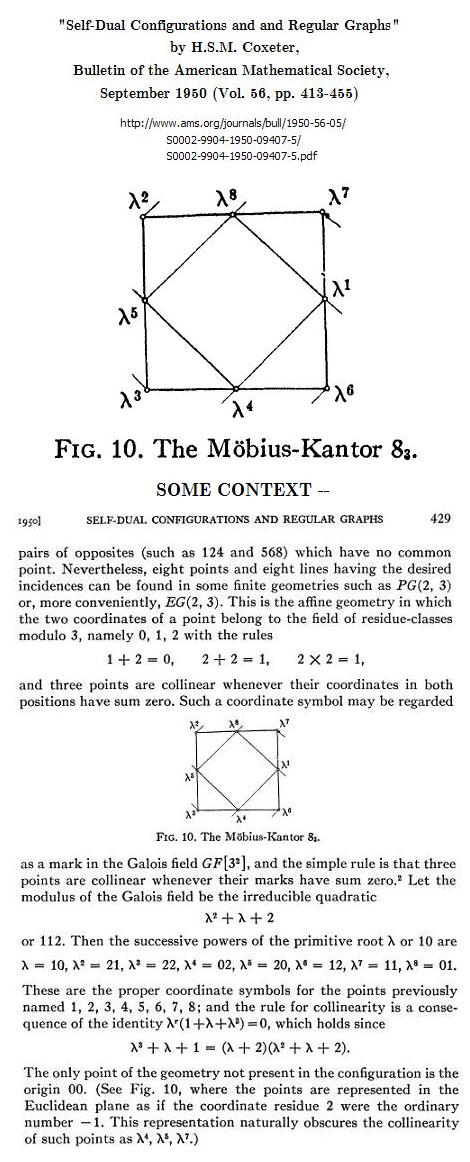
The quaternion illustration above shows a more natural way to picture this geometry—
not with dots representing points in the Euclidean plane, but rather with unit squares
representing points in a finite Galois affine plane. The use of unit squares to
represent points in Galois space allows, in at least some cases, the actions
of finite groups to be represented more naturally than in Euclidean space.
See Galois Geometry, Geometry Simplified, and
Finite Geometry of the Square and Cube.
Comments Off on The Matrix Reloaded
Saturday, June 5, 2010
The history of mathematics continues…
|
PRESS RELEASE
The Academician Professor Nicolaos Artemiadis will give a speech entitled "The Exploration of the Universe through the Mathematical Science" during a public session of the Academy of Athens (the speech will be in Greek).
The public session will be held on Tuesday, January 26th, 2010, at 19:00 at the Academy of Athens.
|
|
For some background on Professor Artemiadis, see two notes of July 2005 (the month an international conference on "Mathematics and Narrative" was held in Greece).
A post related by synchronicity to Artemiadis's Jan. 26 speech— Symbology.
Other philosophical remarks— "The Pediment of Appearance."
Comments Off on Academy Award
Tuesday, May 25, 2010
Darkness Visible
The inevitable tribute to Martin Gardner
has now appeared at the AMS website—

Related Imagery—
The following is an image from Saturday morning—

See also Art Wars and
Mathematics and Narrative.
Comments Off on ART WARS continued
Thursday, April 29, 2010
Mathematics and Narrative
(continued from April 26 and 28):
The Web

See also
Leiber's Big Time, Spider Woman, and The Eight.
Comments Off on Spider Woman
Thursday, December 3, 2009
Mathematics and Narrative, continued…
Out of What Chaos, a novel by Lee Oser—
"This book is more or less what one would expect if Walker Percy wrote about a cynical rock musician who converts to Catholicism, and then Nabokov added some of his verbal pyrotechnics, and then Buster Keaton and the Marquis de Sade and Lionel Trilling inserted a few extra passages. It is a loving and yet appalled description of the underground music scene in the Pacific Northwest. And it is a convincing representation of someone very, very smart."
—Matt Greenfield in The Valve
"If Evelyn Waugh had lived amid the American Northwest rock music scene, he might have written a book like this."
–Anonymous Amazon.com reviewer
A possible source for Oser's title–
"…Lytton Strachey described Pope's theme as 'civilization illumined by animosity; such was the passionate and complicated material from which he wove his patterns of balanced precision and polished clarity.' But out of what chaos did that clarity and precision come!"
—Authors at Work, by Herman W. Liebert and Robert H. Taylor, New York, Grolier Club, 1957, p. 16
Related material:
Unthought Known

and the

White Cube Gallery, 2002
Comments Off on Out of What Chaos
Tuesday, August 18, 2009
Prima Materia
(Background: Art Humor: Sein Feld (March 11, 2009) and Ides of March Sermon, 2009)
From Cardinal Manning's review of Kirkman's Philosophy Without Assumptions—
"And here I must confess… that between something and nothing I can find no intermediate except potentia, which does not mean force but possibility."
— Contemporary Review, Vol. 28 (June-November, 1876), page 1017
Furthermore….
Cardinal Manning, Contemporary Review, Vol. 28, pages 1026-1027:
The following will be, I believe, a correct statement of the Scholastic teaching:–
1. By strict process of reason we demonstrate a First Existence, a First Cause, a First Mover; and that this Existence, Cause, and Mover is Intelligence and Power.
2. This Power is eternal, and from all eternity has been in its fullest amplitude; nothing in it is latent, dormant, or in germ: but its whole existence is in actu, that is, in actual perfection, and in complete expansion or actuality. In other words God is Actus Purus, in whose being nothing is potential, in potentia, but in Him all things potentially exist.
3. In the power of God, therefore, exists the original matter (prima materia) of all things; but that prima materia is pura potentia, a nihilo distincta, a mere potentiality or possibility; nevertheless, it is not a nothing, but a possible existence. When it is said that the prima materia of all things exists in the power of God, it does not mean that it is of the existence of God, which would involve Pantheism, but that its actual existence is possible.
4. Of things possible by the power of God, some come into actual existence, and their existence is determined by the impression of a form upon this materia prima. The form is the first act which determines the existence and the species of each, and this act is wrought by the will and power of God. By this union of form with the materia prima, the materia secunda or the materia signata is constituted.
5. This form is called forma substantialis because it determines the being of each existence, and is the root of all its properties and the cause of all its operations.
6. And yet the materia prima has no actual existence before the form is impressed. They come into existence simultaneously;
[p. 1027 begins]
as the voice and articulation, to use St. Augustine's illustration, are simultaneous in speech.
7. In all existing things there are, therefore, two principles; the one active, which is the form– the other passive, which is the matter; but when united, they have a unity which determines the existence of the species. The form is that by which each is what it is.
8. It is the form that gives to each its unity of cohesion, its law, and its specific nature.*
When, therefore, we are asked whether matter exists or no, we answer, It is as certain that matter exists as that form exists; but all the phenomena which fall under sense prove the existence of the unity, cohesion, species, that is, of the form of each, and this is a proof that what was once in mere possibility is now in actual existence. It is, and that is both form and matter.
When we are further asked what is matter, we answer readily, It is not God, nor the substance of God; nor the presence of God arrayed in phenomena; nor the uncreated will of God veiled in a world of illusions, deluding us with shadows into the belief of substance: much less is it catter [pejorative term in the book under review], and still less is it nothing. It is a reality, the physical kind or nature of which is as unknown in its quiddity or quality as its existence is certainly known to the reason of man.
* "… its specific nature"
(Click to enlarge) —
The Catholic physics expounded by Cardinal Manning above is the physics of Aristotle.
For a more modern treatment of these topics, see Werner Heisenberg's Physics and Philosophy. For instance:
"The probability wave of Bohr, Kramers, Slater, however, meant… a tendency for something. It was a quantitative version of the old concept of 'potentia' in Aristotelian philosophy. It introduced something standing in the middle between the idea of an event and the actual event, a strange kind of physical reality just in the middle between possibility and reality."
Compare to Cardinal Manning's statement above:
"… between something and nothing I can find no intermediate except potentia…"
To the mathematician, the cardinal's statement suggests the set of real numbers between 1 and 0, inclusive, by which probabilities are measured. Mappings of purely physical events to this set of numbers are perhaps better described by applied mathematicians and physicists than by philosophers, theologians, or storytellers. (Cf. Voltaire's mockery of possible-worlds philosophy and, more recently, The Onion's mockery of the fictional storyteller Fournier's quantum flux. See also Mathematics and Narrative.)
Regarding events that are not purely physical– those that have meaning for mankind, and perhaps for God– events affecting conception, birth, life, and death– the remarks of applied mathematicians and physicists are often ignorant and obnoxious, and very often do more harm than good. For such meaningful events, the philosophers, theologians, and storytellers are better guides. See, for instance, the works of Jung and those of his school. Meaningful events sometimes (perhaps, to God, always) exhibit striking correspondences. For the study of such correspondences, the compact topological space [0, 1] discussed above is perhaps less helpful than the finite Galois field GF(64)– in its guise as the I Ching. Those who insist on dragging God into the picture may consult St. Augustine's Day, 2006, and Hitler's Still Point.
Comments Off on Tuesday August 18, 2009
Sunday, August 2, 2009
Spider Girl
"The 'magico-religious' tarantella
is a solo dance performed
supposedly to cure…
the delirium and contortions
attributed to the bite of a spider
at harvest (summer) time."
— Wikipedia

Moral:
Life's a dance
(and Jersey girls
are tough).
 For Mira Sorvino, star of "Tarantella,"
For Mira Sorvino, star of "Tarantella,"
who was raised in Tenafly, New Jersey–
Bull on Sacred Cows:
"Poor late nineteenth-century, poor early twentieth-century! Oh, brave new world that had such people in it: people like Charles Darwin, Karl Marx, Friedrich Nietzsche, Sigmund Freud, Albert Einstein, Werner Heisenberg, Kurt Gödel. Seven people who did more than all the machine-guns and canons of the Somme Valley or the Panzer divisions of Hitler to end the old world and to create– if not the answers– at least the questions that started off the new, each one of them killing one of the sacred cows on which Western consciousness had fed for so long…."
— Apostolos Doxiadis, "Writing Incompleteness-– the Play" (pdf).
See also Mathematics and Narrative.
Comments Off on Sunday August 2, 2009
Thursday, March 19, 2009
Two-Face

[Note: Janus is Roman, not Greek, and
the photo is from one “Fubar Obfusco”]  Click on image for details.
From January 8:
Click on image for details.
From January 8:
Religion and Narrative, continued:
| A Public Square
In memory of
Richard John Neuhaus,
who died today at 72:
“It seems, as one becomes older,
That the past has another pattern,
and ceases to be a mere sequence….”
— T. S. Eliot, Four Quartets

Click on image for details.
See also The Folding.
Posted 1/8/2009 7:00 PM |
|
Context:
Notes on Mathematics and Narrative
(entries in chronological order,
March 13 through 19)
Comments Off on Thursday March 19, 2009
Friday, November 21, 2008
Gatsby Starts Over:
Cleaning Up the
St. Olaf Mess
St. Olaf College,
Northfield, Minnesota —
From The MSCS Mess
(Dept. of Mathematics, Statistics,
and Computer Science)
November 14, 2008
Volume 37, Number 9—
Math Film Festival 2008
The MSCS Department is sponsoring the second of two film-discussion evenings this Wednesday, November 19. Come to RNS 390 at 7:00 PM to see watch [sic] two short [sic]— Whatchu Know 'bout Math and Just a Finite Simple Group of Order Two— and our feature film, Good Will Hunting. Will Hunting is a mathematical genius who's living a rough life in South Boston, while being employed at a prestigious college in Boston, he's [sic] discovered by a Fields Medal winning mathematics Professor [sic] who eventually tries to get Will to turn his life around but becomes haunted by his own professional inadequacies when compared with Will. Professor Garrett will explain the “impossible problem” and its solution after the film.
Background:
Log24 entries of Wednesday, November 19, the day "Good Will Hunting" was shown:
Damnation Morning revisited and
Mathematics and Narrative continued
From
a story in the November 21
Chronicle of Higher Education
on a recent St. Olaf College
reading of
Paradise Lost:
" Of man's first disobedience,
and the fruit
Of that forbidden tree,
whose mortal taste
Brought death into the World,
and all our woe….
A red apple made the rounds,
each reader tempting the next." |
Comments Off on Friday November 21, 2008
Wednesday, November 19, 2008
"Through the unknown,
remembered gate…."
— Four Quartets
(Epigraph to the introduction,
Parallelisms of Complete Designs
by Peter J. Cameron,
Merton College, Oxford)
"It's still the same old story…."
— Song lyric
The Great Gatsby, Chapter 6:
"An instinct toward his future glory had led him, some months before, to the small Lutheran college of St. Olaf in southern Minnesota. He stayed there two weeks, dismayed at its ferocious indifference to the drums of his destiny, to destiny itself, and despising the janitor’s work with which he was to pay his way through."
There is a link to an article on St. Olaf College in Arts & Letters Daily today:
"John Milton, boring? Paradise Lost has a little bit of something for everybody. Hot sex! Hellfire! Some damned good poetry, too…" more»
The "more" link is to The Chronicle of Higher Education.
For related material on Paradise Lost and higher education, see Mathematics and Narrative.
Comments Off on Wednesday November 19, 2008
Sunday, April 13, 2008
The Echo
in Plato’s Cave
“It is said that the students of medieval Paris came to blows in the streets over the question of universals. The stakes are high, for at issue is our whole conception of our ability to describe the world truly or falsely, and the objectivity of any opinions we frame to ourselves. It is arguable that this is always the deepest, most profound problem of philosophy.”
— Simon Blackburn, Think (Oxford, 1999)
Michael Harris, mathematician at the University of Paris:
“… three ‘parts’ of tragedy identified by Aristotle that transpose to fiction of all types– plot (mythos), character (ethos), and ‘thought’ (dianoia)….”
— paper (pdf) to appear in Mathematics and Narrative, A. Doxiadis and B. Mazur, eds.
Mythos —
A visitor from France this morning viewed the entry of Jan. 23, 2006: “In Defense of Hilbert (On His Birthday).” That entry concerns a remark of Michael Harris.
A check of Harris’s website reveals a new article:
“Do Androids Prove Theorems in Their Sleep?” (slighly longer version of article to appear in Mathematics and Narrative, A. Doxiadis and B. Mazur, eds.) (pdf).
From that article:
“The word ‘key’ functions here to structure the reading of the article, to draw the reader’s attention initially to the element of the proof the author considers most important. Compare E.M. Forster in Aspects of the Novel:
[plot is] something which is measured not be minutes or hours, but by intensity, so that when we look at our past it does not stretch back evenly but piles up into a few notable pinnacles.”
Ethos —
“Forster took pains to widen and deepen the enigmatic character of his novel, to make it a puzzle insoluble within its own terms, or without. Early drafts of A Passage to India reveal a number of false starts. Forster repeatedly revised drafts of chapters thirteen through sixteen, which comprise the crux of the novel, the visit to the Marabar Caves. When he began writing the novel, his intention was to make the cave scene central and significant, but he did not yet know how:
When I began a A Passage to India, I knew something important happened in the Malabar (sic) Caves, and that it would have a central place in the novel– but I didn’t know what it would be… The Malabar Caves represented an area in which concentration can take place. They were to engender an event like an egg.”
— E. M. Forster: A Passage to India, by Betty Jay
Dianoia —
Flagrant Triviality
or Resplendent Trinity?
“Despite the flagrant triviality of the proof… this result is the key point in the paper.”
— Michael Harris, op. cit., quoting a mathematical paper
Online Etymology Dictionary:
flagrant c.1500, “resplendent,” from L. flagrantem (nom. flagrans) “burning,” prp. of flagrare “to burn,” from L. root *flag-, corresponding to PIE *bhleg– (cf. Gk. phlegein “to burn, scorch,” O.E. blæc “black”). Sense of “glaringly offensive” first recorded 1706, probably from common legalese phrase in flagrante delicto “red-handed,” lit. “with the crime still blazing.”
A related use of “resplendent”– applied to a Trinity, not a triviality– appears in the Liturgy of Malabar:
— The Liturgies of SS. Mark, James, Clement, Chrysostom, and Basil, and the Church of Malabar, by the Rev. J.M. Neale and the Rev. R.F. Littledale, reprinted by Gorgias Press, 2002
On Universals and
A Passage to India:
“”The universe, then, is less intimation than cipher: a mask rather than a revelation in the romantic sense. Does love meet with love? Do we receive but what we give? The answer is surely a paradox, the paradox that there are Platonic universals beyond, but that the glass is too dark to see them. Is there a light beyond the glass, or is it a mirror only to the self? The Platonic cave is even darker than Plato made it, for it introduces the echo, and so leaves us back in the world of men, which does not carry total meaning, is just a story of events.”
Comments Off on Sunday April 13, 2008
Monday, April 9, 2007
Symmetry
for Beavis and Butt-Head

(An illustration from
Mathematics and Narrative;
the “Book” is
The Gospel
According to St. Matthew.)
“
Is Beauty Truth and Truth Beauty?,”
a review by famed vulgarizer
Martin Gardner of the new book
by his fellow vulgarizer Ian Stewart
in the April 2007
Scientific American:
“Associated with every kind of symmetry is a ‘group.’ Stewart explains the group concept in a simple way by considering operations on an equilateral triangle. Rotate it 60 degrees in either direction, and it looks the same. Every operation has an ‘inverse,’ that cancels the operation. Imagine the corners of the triangle labeled A, B and C. A 60-degree clockwise rotation alters the corners’ positions. If this is followed by a similar rotation the other way, the original positions are restored. If you do nothing to the triangle, this is called the ‘identity’ operation. The set of all symmetry transformations of the triangle constitutes its group.”
“Is Beauty Truth?”
asked jesting Gardner…
The reasoned reply of
Beavis and Butt-Head:
“Sixty degrees, a hundred
and twenty degrees, who
gives a rat’s ass?”
Tuesday, January 9, 2007
For Balanchine's Birthday
(continued from
January 9, 2003)
George Balanchine
Encyclopædia Britannica Article
born January 22
[January 9, Old Style], 1904,
St. Petersburg, Russia
died April 30, 1983, New York,
New York, U.S.

George Balanchine.
©1983 Martha Swope
original name
Georgy Melitonovich Balanchivadze
most influential choreographer of classical ballet in the United States in the 20th century. His works, characterized by a cool neoclassicism, include The Nutcracker (1954) and Don Quixote (1965), both pieces choreographed for the New York City Ballet, of which he was a founder (1948), the artistic director, and the…
Balanchine, George… (75 of 1212 words)
|
"What on earth is
a concrete universal?"
— Robert M. Pirsig
Review:
From Wikipedia's
"Upper Ontology"
and
Epiphany 2007:
"There is no neutral ground
that can serve as
a means of translating between
specialized (lower) ontologies."
There is, however,
"the field of reason"–
the 3×3 grid:

Click on grid
for details.
As Rosalind Krauss
has noted, some artists
regard the grid as
"a staircase to
the Universal."
Other artists regard
Epiphany itself as an
approach to
the Universal:
"Epiphany signals the traversal
of the finite by the infinite,
of the particular by the universal,
of the mundane by the mystical,
of time by eternity."
— Richard Kearney, 2005,
in The New Arcadia Review

Kearney (right) with
Martin Scorsese (left)
and Gregory Peck
in 1997.
"… one of the things that worried me about traditional metaphysics, at least as I imbibed it in a very Scholastic manner at University College Dublin in the seventies, is that philosophy was realism and realism was truth. What disturbed me about that was that everything was already acquired; truth was always a systematic given and it was there to be learned from Creation onwards; it was spoken by Jesus Christ and then published by St. Thomas Aquinas: the system as perfect synthesis. Hence, my philosophy grew out of
a hunger for the 'possible' and it was definitely a reaction to my own philosophical formation. Yet that wasn't my only reaction. I was also reacting to what I considered to be the deep pessimism, and even at times 'nihilism' of the postmodern turn."
— Richard Kearney, interview (pdf) in The Leuven Philosophy Newsletter, Vol. 14, 2005-2006
For more on "the possible," see Kearney's The God Who May Be, Diamonds Are Forever, and the conclusion of Mathematics and Narrative:
"We symbolize
logical necessity
with the box ( ) )
and logical possibility
with the diamond ( )." )."
— Keith Allen Korcz

"The possibilia that exist,
and out of which
the Universe arose,
are located in
a necessary being…."
— Michael Sudduth,
Notes on
God, Chance, and Necessity
by Keith Ward,
Regius Professor of Divinity,
Christ Church College, Oxford
(the home of Lewis Carroll)
|
Friday, December 29, 2006
Tools
of Christ Church
"For every kind of vampire,
there is a kind of cross."
— Thomas Pynchon

Click on picture for details.
Today is the feast
of St. Thomas Becket.
In his honor, a meditation
on tools and causation:
"Lewis Wolpert, an eminent developmental biologist at University College London, has just published
Six Impossible Things Before Breakfast, a pleasant, though rambling, look at the biological basis of belief. While the book focuses on our ability to form causal beliefs about everyday matters (the wind moved the trees, for example), it spends considerable time on the origins of religious and moral beliefs. Wolpert defends the unusual idea that causal thinking is an adaptation required for tool-making. Religious beliefs can thus be seen as
an odd extension of causal thinking about technology to more mysterious matters. Only a species that can reason causally could assert that 'this storm was sent by God because we sinned.' While Wolpert's attitude toward religion is tolerant, he's an atheist who seems to find religion more puzzling than absorbing."
— Review by H. Allen Orr in
The New York Review of Books,
Vol. 54, No. 1, January 11, 2007
"An odd extension"–
Wolpert's title is, of course,
from Lewis Carroll.
Related material:
"It's a poor sort of memory
that only works backwards."
— Through the Looking-Glass
An event at the Kennedy Center
broadcast on
December 26, 2006
(St. Steven's Day):
"Conductor John Williams, a 2004 Honoree, says, 'Steven, sharing our 34-year collaboration has been a great privilege for me. It's been an inspiration to watch you dream your dreams, nurture them and make them grow. And, in the process, entertain and edify billions of people around the world. Tonight we'd like to salute you, musically, with a piece that expresses that spirit beautifully … It was written by Leonard Bernstein, a 1980 Kennedy Center Honoree who was, incidentally, the first composer to be performed in this hall.' Backed by The United States Army Chorus and The Choral Arts Society, soprano Harolyn Blackwell and tenor Gregory Turay sing the closing number for Spielberg's tribute and the gala itself. It's the finale to the opera 'Candide,' 'Make Our Garden Grow,' and Williams conducts."
— CBS press release
See also the following,
from the conclusion to
"Mathematics and Narrative"
(Log24, Aug. 22, 2005):

"At times, bullshit can
only be countered
with superior bullshit."
— Norman Mailer
Many Worlds and Possible Worlds in Literature and Art, in Wikipedia:
"The concept of possible worlds dates back to at least Leibniz who in his Théodicée tries to justify the apparent imperfections of the world by claiming that it is optimal among all possible worlds. Voltaire satirized this view in his picaresque novel Candide….
Borges' seminal short story El jardín de senderos que se bifurcan ("The Garden of Forking Paths") is an early example of many worlds in fiction."
"Il faut cultiver notre jardin."
— Voltaire
"We symbolize
logical necessity
with the box ( )
)
and logical possibility
with the diamond ( )."
)."
— Keith Allen Korcz

"The possibilia that exist,
and out of which
the Universe arose,
are located in
a necessary being…."
— Michael Sudduth,
Notes on
God, Chance, and Necessity
by Keith Ward,
Regius Professor of Divinity,
Christ Church College, Oxford
(the home of Lewis Carroll)
For further details,
click on the
Christ Church diamond.
Comments Off on Friday December 29, 2006
Monday, December 18, 2006
Fade to Black:
Martin Gardner in the Notices of the American Mathematical Society, June/July 2005 (pdf):
“I did a column in Scientific American on minimal art, and I reproduced one of Ed Rinehart’s [sic] black paintings. Of course, it was just a solid square of pure black.”

Click on picture
for details.
The Notices of the American Mathematical Society, January 2007 (pdf):
“This was just one of the many moments in this sad tale when there were no whistle-blowers. As a result the entire profession has received a very public and very bad black mark.”
— Joan S. Birman
Professor Emeritus of Mathematics
Barnard College and
Columbia University
Comments Off on Monday December 18, 2006
Wednesday, December 6, 2006
Tompkins was found dead
on December 1, 2006.
From Log24 on that date:

That entry contained an excerpt from
Tom Wolfe’s The Painted Word—
“What I saw before me was the critic-in-chief of The New York Times saying: In looking at a painting today, ‘to lack a persuasive theory is to lack something crucial.’ I read it again. It didn’t say ‘something helpful’ or ‘enriching’ or even ‘extremely valuable.’ No, the word was crucial….”
The story deals with “one Gideon Summerfield, deceased.” Summerfield, a former tutor at (the fictional) St. Agatha’s College, Cambridge University, “is about to become the recipient of the Waymark prize. This prize is awarded in Mathematics and has the same prestige as the Nobel. Summerfield had a rather lackluster career at St. Agatha’s, with the exception of one remarkable result that he obtained. It is for this result that he is being awarded the prize, albeit posthumously.” Someone is apparently trying to prevent a biography of Summerfield from being published.
The following page contains
a critical part of the solution
to the mystery:
Comments Off on Wednesday December 6, 2006
Tuesday, October 24, 2006
Here is an interpretation
of those numbers:
"The geometrization conjecture, also known as Thurston's geometrization conjecture, concerns the geometric structure of compact 3-manifolds.
The geometrization conjecture can be considered an analogue for 3-manifolds of the uniformization theorem for surfaces. It was proposed by William Thurston in the late 1970s. It 'includes' other conjectures, such as the Poincaré conjecture and the Thurston elliptization conjecture."
The second sentence, in bold type, was added on 8/21 by yours truly. No deep learning or original thought was required to make this important improvement in the article; the sentence was simply copied from the then-current version of the article on Grigori Perelman (who has, it seems, proved the geometrization conjecture).
This may serve as an example of the "mathematics" part of the above phrase "Mathematics and Narrative" — a phrase which served, with associated links, as the Log24 entry for 8/21.
7/23 — Narrative:
"Each step in the story is a work of art, and the story as a whole is a sequence of episodes of rare beauty, a drama built out of nothing but numbers and imagination." –Freeman Dyson
This quotation appeared in the Log24 entry for 7/23, "Dance of the Numbers." What Dyson calls a "story" or "drama" is in fact mathematics. (Dyson calls the "steps" in the story "works of art," so it is clear that Dyson (a former student of G. H. Hardy) is discussing mathematical steps, not paragraphs in someone's account– perhaps a work of art, perhaps not– of mathematical history.) I personally regard the rhetorical trick of calling the steps leading to a mathematical result a "story" as contemptible vulgarization, but Dyson, as someone whose work (pdf) led to the particular result he is discussing, is entitled to dramatize it as he pleases.
For related material on mathematics, narrative, and vulgarization, click here.
The art of interpretation (applied above to a lottery) is relevant to narrative and perhaps also, in some sense, to the arts of mathematical research and exposition (if not to mathematics itself). This art is called hermeneutics.
For more on the subject, see the Stanford Encyclopedia of Philosophy article on Hans-Georg Gadamer, "the decisive figure in the development of twentieth-century hermeneutics."
"Foreword" in Gian-Carlo Rota,
Indiscrete Thoughts,
Boston: Birkhäuser Verlag,
1996, xiii-xvii, and
"Gadamer's Theory of Hermeneutics" in
The Philosophy of Hans-Georg Gadamer,
edited by Lewis E. Hahn,
The Library of Living Philosophers, Vol. 24,
Chicago: Open Court Publishers,
1997, 223-34.
Comments Off on Tuesday October 24, 2006
Wednesday, September 13, 2006
ART WARS continued:
The Krauss Cross

Rosalind Krauss in "Grids":
"If we open any tract– Plastic Art and Pure Plastic Art or The Non-Objective World, for instance– we will find that Mondrian and Malevich are not discussing canvas or pigment or graphite or any other form of matter. They are talking about Being or Mind or Spirit. From their point of view, the grid is a staircase to the Universal, and they are not interested in what happens below in the Concrete.
Or, to take a more up-to-date example, we could think about Ad Reinhardt who, despite his repeated insistence that 'Art is art,' ended up by painting a series of black nine-square grids in which the motif that inescapably emerges is a Greek cross. There is no painter in the West who can be unaware of the symbolic power of the cruciform shape and the Pandora's box of spiritual reference that is opened once one uses it."
Rebecca Goldstein on
Mathematics and Narrative:
"I don't write exclusively on Jewish themes or about Jewish characters. My collection of short stories, Strange Attractors, contained nine pieces, five of which were, to some degree, Jewish, and this ratio has provided me with a precise mathematical answer (for me, still the best kind of answer) to the question of whether I am a Jewish writer. I am five-ninths a Jewish writer."
Jacques Maritain,
October 1941:
"The passion of Israel
today is taking on
more and more distinctly
the form of the Cross."
E. L. Doctorow,
City of God:
"In the garden of Adding,
Live Even and Odd."
Comments Off on Wednesday September 13, 2006
Thursday, August 17, 2006
Special Topics
From a review by Liesl Schillinger in the Aug. 13 New York Times of a new novel by Marisha Pessl:
“… Special Topics in Calamity Physics tells the story of a wise newcomer who joins a circle of students who orbit a charismatic teacher with a tragic secret. The newcomer, a motherless waif named Blue van Meer, spent most of her life driving between college towns with her genius poli-sci professor father, Gareth…. Gareth is fond of making oracular statements, which his daughter laps up as if they were Churchill’s: ‘Everyone is responsible for the page-turning tempo of his or her Life Story,’ he tells her. And, he cautions, ‘never try to change the narrative structure of someone else’s story.’
…. Heeding Gareth van Meer’s dictum that the most page-turning read known to man is the collegiate curriculum, with its ‘celestial, sweet set of instructions, culminating in the scary wonder of the Final Exam,’ Pessl structures Blue’s mystery like a kind of Great Books class…. A professor is all-powerful, Gareth liked to tell his daughter, he puts ‘a veritable frame around life,’ and ‘organizes the unorganizable. Nimbly partitions it into modern and postmodern, renaissance, baroque, primitivism, imperialism and so on. Splice that up with Research Papers, Vacation, Midterms. All that order– simply divine.’ Blue’s syllabus also includes a murder or two. Her book’s last pages are a final exam. You will be relieved to learn it is mostly multiple choice, and there is no time limit.”
Multiple choice:
The examination below, taken from a page by a scholar at a Jesuit university, is on the Borges story “The Garden of Forking Paths”– a classic of multiple choice.
No time limit:
See the first question.
Examination on
“The Garden of Forking Paths“

“What is the meaning of the idea expressed by Yu Tsun that ‘everything happens to a man precisely, precisely now. Centuries of centuries and only in the present do things happen’? What is the significance of the emphasis on the present moment, the here and now? Is this related to the carpe diem (‘seize the day’) idea? How? How is the present effectively connected to the past and the future? How is the present associated simultaneously to choices, actions, and consequences? How is the present moment relevant to the idea of the ‘forking paths’? What is the symbolic meaning of forking paths when understood as a crossroads? What is a person confronted with when standing at a crossroads? What are the implications of a choice of road? May this be connected to the myth of Oedipus and its concerns with human choices and supposed predestination? What is suggested by the idea that ‘in all fictional works, each time a man is confronted with several alternatives, he chooses one and eliminates the others; in the fiction of Ts’ui Pen, he chooses– simultaneously– all of them. He creates, in this way, diverse futures, diverse times which themselves also proliferate and fork’? What does it mean to make all choices at once? What view of life do such beliefs embody?”
Saturday, July 29, 2006
Big Rock
Thanks to Ars Mathematica, a link to everything2.com:
“In mathematics, a big rock is a result which is vastly more powerful than is needed to solve the problem being considered. Often it has a difficult, technical proof whose methods are not related to those of the field in which it is applied. You say ‘I’m going to hit this problem with a big rock.’ Sard’s theorem is a good example of a big rock.”
Another example:
Properties of the Monster Group of R. L. Griess, Jr., may be investigated with the aid of the Miracle Octad Generator, or MOG, of R. T. Curtis. See the MOG on the cover of a book by Griess about some of the 20 sporadic groups involved in the Monster:
The MOG, in turn, illustrates (via Abstract 79T-A37, Notices of the American Mathematical Society, February 1979) the fact that the group of automorphisms of the affine space of four dimensions over the two-element field is also the natural group of automorphisms of an arbitrary 4×4 array.
This affine group, of order 322,560, is also the natural group of automorphisms of a family of graphic designs similar to those on traditional American quilts. (See the diamond theorem.)
This top-down approach to the diamond theorem may serve as an illustration of the “big rock” in mathematics.
For a somewhat simpler, bottom-up, approach to the theorem, see Theme and Variations.
For related literary material, see Mathematics and Narrative and The Diamond as Big as the Monster.
“The rock cannot be broken.
It is the truth.”
— Wallace Stevens,
“Credences of Summer”
Comments Off on Saturday July 29, 2006
Thursday, July 27, 2006
Number Sense
The NY lottery numbers for yesterday, 7/26, Jung's birthday, were 726 (mid-day) and 970 (evening).
We may view these numbers as representing the Jungian "sheep" and Freudian "goats" of yesterday's entry Partitions.
For the Jungian coincidence of 726 with 7/26, recall the NY lottery number 911 that was drawn on 9/11 exactly a year after the destruction of the World Trade Center. For more on this coincidence, see For Hemingway's Birthday: Mathematics and Narrative Continued (July 21, 2006).
For 970, Google reveals a strictly skeptical (i.e., like Freud, not Jung) meaning: 970 is the first page of the article "Sources of Mathematical Thinking," in Science, 7 May 1999: Vol. 284. no. 5416, pp. 970 – 974.
That article has been extensively cited in the scholarly literature on the psychology of mathematics. Its lead author, Stanislas Dehaene, has written a book, The Number Sense.
What sense, if any, is made by 726 and 970?
The mid-day number again (see Hemingway's birthday) illustrates the saying
"Time and chance happeneth to them all."
The evening number again illustrates the saying
"Though truth may be very hard to find in the pages of most books, the page numbers are generally reliable."
— Steven H. Cullinane,
Zen and Language Games
These sayings may suit the religious outlook of Susan Blackmore, source (along with Matthew 25:31-46) of the sheep/goats partition in yesterday's entry on that topic. She herself, apparently a former sheep, is now a goat practicing Zen.
Update of later the same evening–
On Space, Time, Life, the Universe, and Everything:
Note that the "sheep" number 726 has a natural interpretation as a date– i.e., in terms of time, while the "goat" number 970 has an interpretation as a page number– i.e., in terms of space. Rooting, like Jesus and St. Matthew, for the sheep, we may interpret both of today's NY lottery results as dates, as in the next entry, Real Numbers. That entry may (or may not) pose (and/or answer) The Ultimate Question. Selah.
Comments Off on Thursday July 27, 2006
Monday, July 24, 2006
Discourse Analysis
Edward Rothstein in today’s New York Times, reviewing Evil Incarnate (Princeton University Press):
“… the most decisive aspect of the myth is that it is, literally, a myth. Every single example of evil he gives turns out to be evil imagined: there is, he says, no evidence for any of it. Evil, he argues, is not something real, it is a ‘discourse,’ a ‘way of representing things and shaping our experience, not some force in itself.'”
Related material:
A review (pdf) by Steven G. Krantz of Charles Wells’s A Handbook of Mathematical Discourse (Notices of the American Mathematical Society, September 2004):
“Ambrose Bierce’s Devil’s Dictionary is a remarkable and compelling piece of writing because of its searing wit and sardonic take on life. Bierce does not define any new words. He instead gives deadly interpretations of very familiar words. Wells’s book does not fit into the same category of literary effort.”
For literary efforts perhaps more closely related to Bierce’s, see Mathematics and Narrative and the five Log24 entries ending on this date last year.
Comments Off on Monday July 24, 2006
Friday, July 21, 2006
For Hemingway’s birthday:
Mathematics and Narrative, continued
“We know many little things about the relation between mathematics and narrative, but lack one big comprehensive insight.”
— John Allen Paulos (pdf)
“On Wednesday, Sept. 11, 2002– 9/11/02– the New York State lottery numbers were 911, an eerie coincidence that set many people to thinking or, perhaps more accurately, to not thinking.”
— John Allen Paulos
“Time and chance happeneth to them all.”
— Ecclesiastes 9:11
Comments Off on Friday July 21, 2006
Sunday, July 16, 2006
Mathematics and Narrative
continued…
“Now, at the urging of the UC Berkeley cognitive linguist George Lakoff, liberal America’s guru of the moment, progressive Democrats are practicing to get their own reluctant mouths around some magical new vocabulary, in the hope of surviving and eventually overcoming the age of Bush.”
— Marc Cooper in The Atlantic Monthly, April 2005, “Thinking of Jackasses: The Grand Delusions of the Democratic Party”
Cooper’s “now” is apparently still valid. In today’s New York Times, the leftist Stanley Fish reviews Talking Right, by leftist Geoffrey Nunberg:
“… the right’s language is now the default language for everyone.
On the way to proposing a counterstrategy (it never really arrives), Nunberg pauses to engage in a polite disagreement with his fellow linguist George Lakoff, who has provided a rival account of the conservative ascendancy. Lakoff argues that Republicans have articulated– first for themselves and then for others– a conceptual framework that allows them to unite apparently disparate issues in a single coherent worldview … woven together not in a philosophically consistent framework but in a narrative ‘that creates an illusion of coherence.’
Once again, the Republicans have such a narrative– ‘declining patriotism and moral standards, the out-of-touch media and the self-righteous liberal elite … minorities demanding special privileges … disrespect for religious faith, a swollen government’– but ‘Democrats and liberals have not offered compelling narratives that could compete’ with it. Eighty pages later he is still saying the same thing. ‘The Democrats need a compelling narrative of their own.'”
Lakoff is the co-author of a book on the philosophy of mathematics, Where Mathematics Comes From: How the Embodied Mind Brings Mathematics into Being. From Wikipedia’s article on Lakoff:
“According to Lakoff, even mathematics itself is subjective to the human species and its cultures: thus ‘any question of math’s being inherent in physical reality is moot, since there is no way to know whether or not it is.’ Lakoff and Rafael E. Nunez (2000) argue at length that mathematical and philosophical ideas are best understood in light of the embodied mind. The philosophy of mathematics ought therefore to look to the current scientific understanding of the human body as a foundation ontology, and abandon self-referential attempts to ground the operational components of mathematics in anything other than ‘meat.'”
For a long list of related leftist philosophy, see The Thinking Meat Project.
Democrats seeking narratives may also consult The Carlin Code and The Prime Cut Gospel.
Comments Off on Sunday July 16, 2006
Sunday, July 2, 2006
The Rock and the Serpent
In a search for a title to express
the contrast between truth and lies,
an analogy between the phrases
“Crystal and Dragon” and
“Mathematics and Narrative“
suggests a similar phrase,
“The Rock and the Serpent.”
A web search for related titles leads to a book by Alice Thomas Ellis:
Serpent on the Rock: A Personal View of Christianity. (See a review.)
(This in turn leads to an article on Ellis’s husband, the late Colin Haycraft, publisher.)
For an earlier discussion of Ellis in this weblog, see Three Eleanors (March 12, 2005).
That entry brings us back to the theme of truth and lies with its link to an article from the Catholic publication Commonweal:
Getting to Truth by Lying.
Christians who wish to lie more effectively may consult a book by the author of the Commonweal article:

For a more sympathetic view of
suffering stemming from
Christian narrative,
see

(Click on cover
for details. See also Log24
entries on Guy Davenport,
who wrote the foreword.)
Comments Off on Sunday July 2, 2006
Monday, June 19, 2006
Snippets:
A Reply to John Updike
See Updike on digitized snippets.
The following four snippets were pirated from the end of MathPages Quotations, compiled by Kevin Brown.
They are of synchronistic interest in view of the previous two Log24 entries, which referred (implicitly) to a Poe story and (explicitly) to Pascal.
"That is another of your odd notions,"
said the Prefect, who had the fashion
of calling everything 'odd' that was
beyond his comprehension, and thus
lived amid an absolute legion of 'oddities.'
Edgar Allan Poe
I knew when seven justices could not
take up a quarrel, but when the parties
were met themselves, one of them
thought but of an If, as, 'If you said so,
then I said so'; and they shook hands
and swore brothers. Your If is the only
peacemaker; much virtue in If.
Shakespeare
I have made this letter longer than usual
because I lack the time to make it shorter.
Blaise Pascal
S'io credessi che mia risposta fosse
a persona che mai tornasse al mondo,
questa fiamma staria senza piu scosse.
Ma per cio che giammai di questo fondo
non torno vivo alcun, s'i'odo il vero,
senza tema d'infamia ti rispondo.
Dante, 1302
For translations of the Dante (including one by Dorothy Sayers), see everything2.com.
An anonymous author there notes that Dante describes a flame in which is encased a damned soul. The flame vibrates as the soul speaks:
If I thought that I were making
Answer to one that might return to view
The world, this flame should evermore
cease shaking.
But since from this abyss, if I hear true,
None ever came alive, I have no fear
Of infamy, but give thee answer due.
-- Dante, Inferno, Canto 27, lines 61-66,
translated by Dorothy Sayers
Updike says,
“Yes, there is a ton of information on the web but much of it is grievously inaccurate, unedited, unattributed and juvenile. The electronic marvels that abound around us serve, I have the impression, to inflame what is most informally and non-critically human about us. Our computer screens stare back at us with a kind of giant, instant aw-shucks, disarming in its modesty.”
Note Updike’s use of “inflame.”
For an aw-shucks version of “what is most informally and non-critically human about us,” as well as a theological flame, see both the previous entry and the above report from Hell.
Note that the web serves also to correct material that is inaccurate, unedited, unattributed, and juvenile. For examples, see Mathematics and Narrative. The combination of today’s entry for Pascal’s birthday with that web page serves both to light one candle and to curse the darkness.
Comments Off on Monday June 19, 2006
Monday, May 29, 2006
For John F. Kennedy's birthday:
Comments Off on Monday May 29, 2006
Monday, May 22, 2006
A Kind of Cross
Google Maps image
of the isle of Delos,
birthplace of Apollo:

“I faced myself that day with
the nonplused apprehension
of someone who has
come across a vampire
and has no crucifix in hand.”
— Joan Didion, “On Self-Respect,”
in Slouching Towards Bethlehem
“For every kind of vampire,
there is a kind of cross.”
— Thomas Pynchon,
Gravity’s Rainbow

Related material:
Mathematics and Narrative,
Secret Passages
Comments Off on Monday May 22, 2006
Friday, May 19, 2006
Star and Diamond
continued
” ‘I know what it is you last saw,’ she said; ‘for that is also in my mind. Do not be afraid! But do not think that only by singing amid the trees, nor even by the slender arrows of elvenbows, is this land of Lothlórien maintained and defended against the Enemy. I say to you, Frodo, that even as I speak to you, I perceive the Dark Lord and know his mind, or all his mind that concerns the Elves. And he gropes ever to see me and my thought. But still the door is closed!’
She lifted up her white arms, and spread out her hands towards the East in a gesture of rejection and denial. Eärendil, the Evening Star, most beloved of the Elves, shone clear above. So bright was it that the figure of the Elven-lady cast a dim shadow on the ground. Its ray glanced upon a ring about her finger; it glittered like polished gold overlaid with silver light, and a white stone in it twinkled as if the Even-star had come to rest upon her hand. Frodo gazed at the ring with awe; for suddenly it seemed to him that he understood.
‘Yes,’ she said, divining his thought, ‘it is not permitted to speak of it, and Elrond could not do so. But it cannot be hidden from the Ring-Bearer, and one who has seen the Eye. Verily it is in the land of Lórien upon the finger of Galadriel that one of the Three remains. This is Nenya, the Ring of Adamant, and I am its keeper.’ ”
— J. R. R. Tolkien, The Lord of the Rings
Comments Off on Friday May 19, 2006
Older Posts »













 .
.



























 .
.











































































































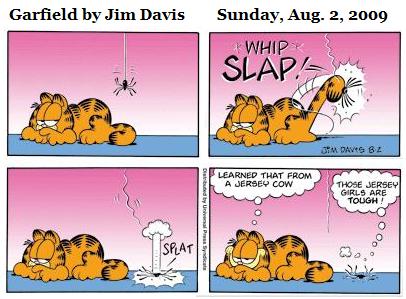
 For Mira Sorvino, star of "Tarantella,"
For Mira Sorvino, star of "Tarantella,"





